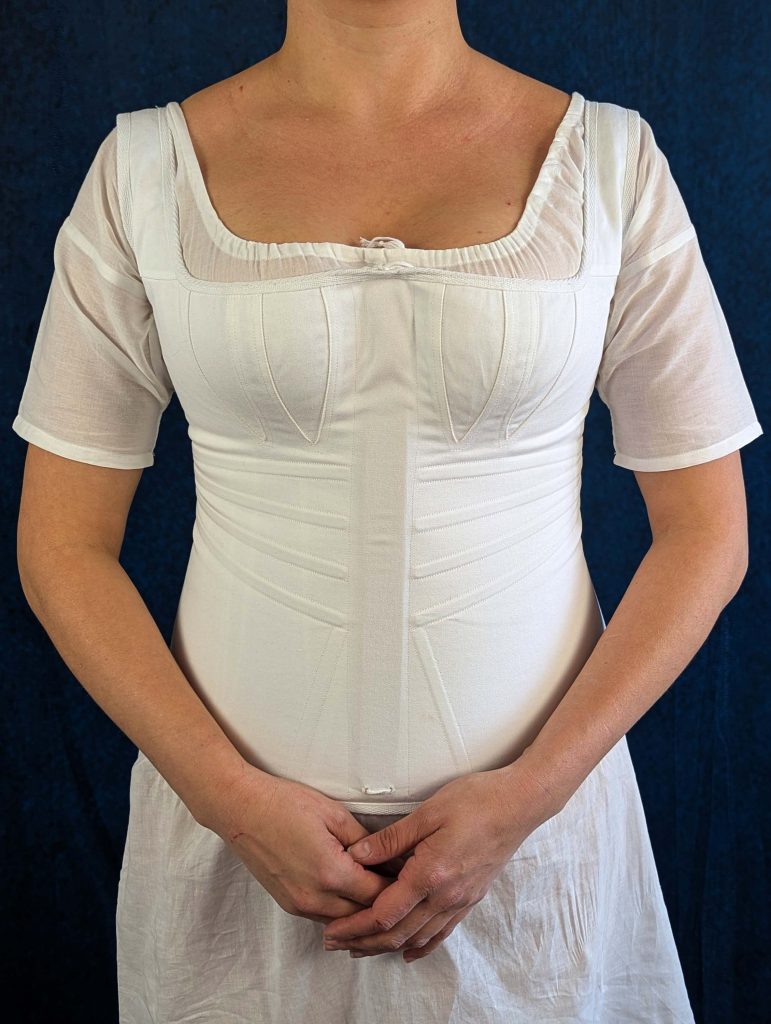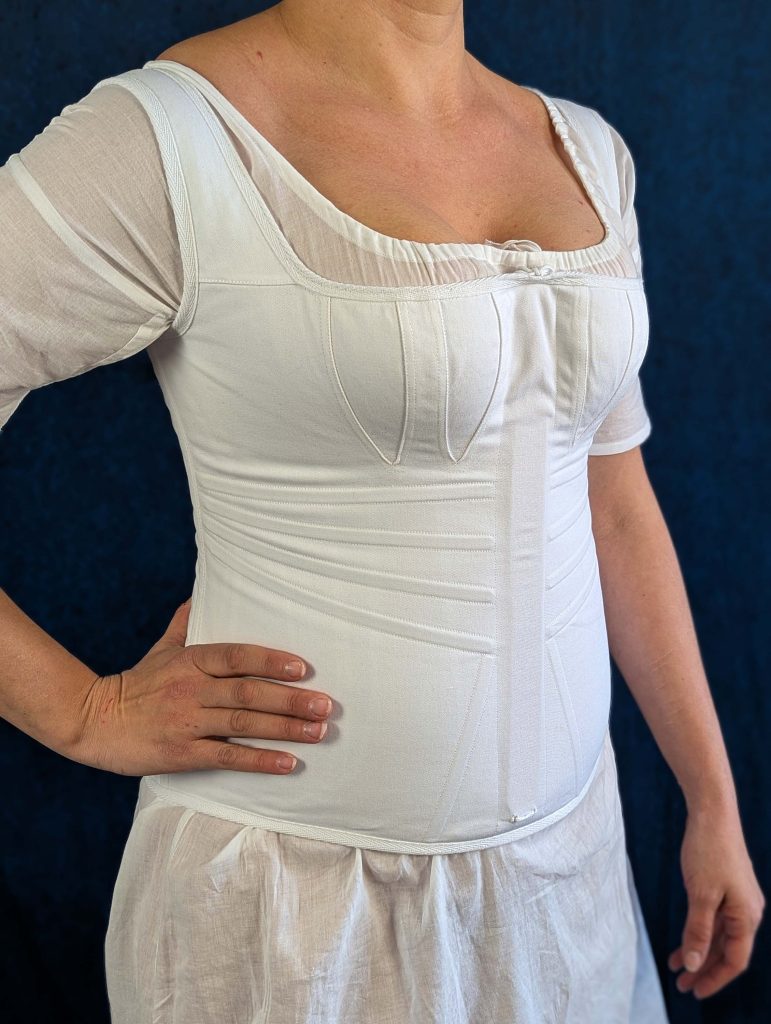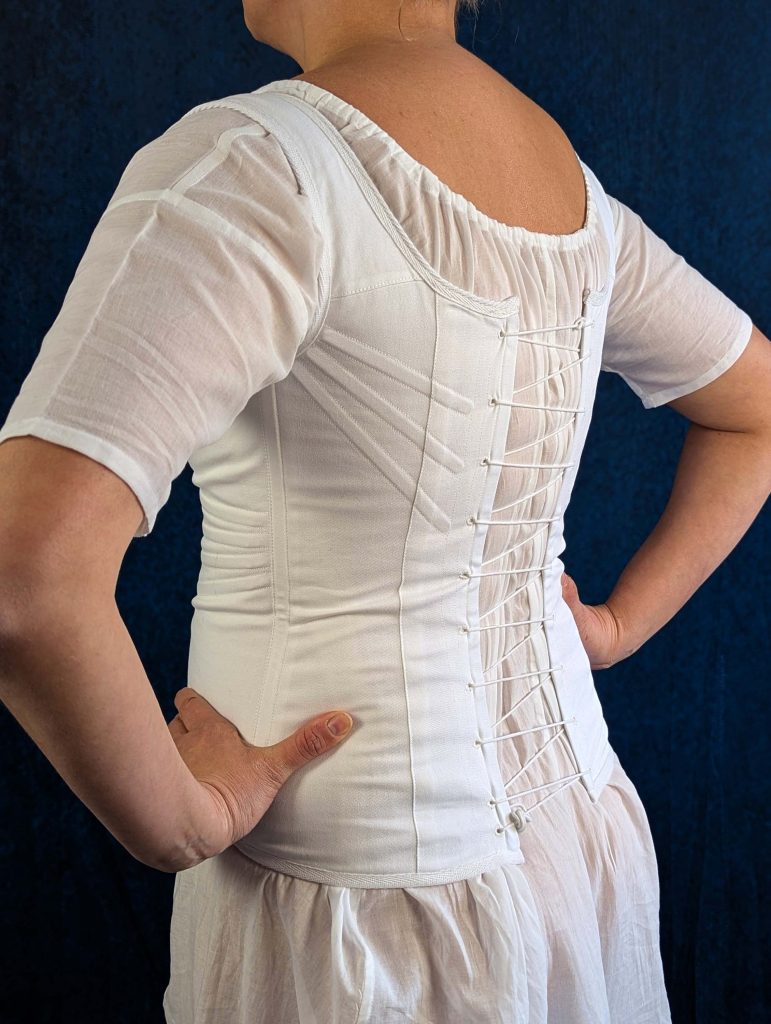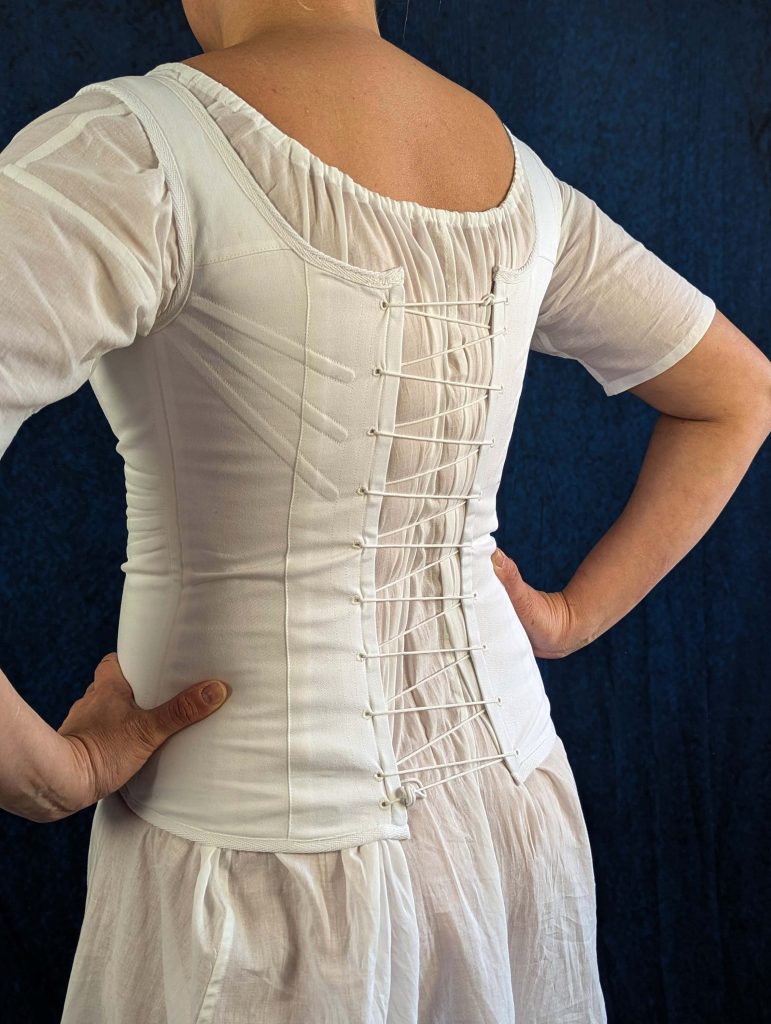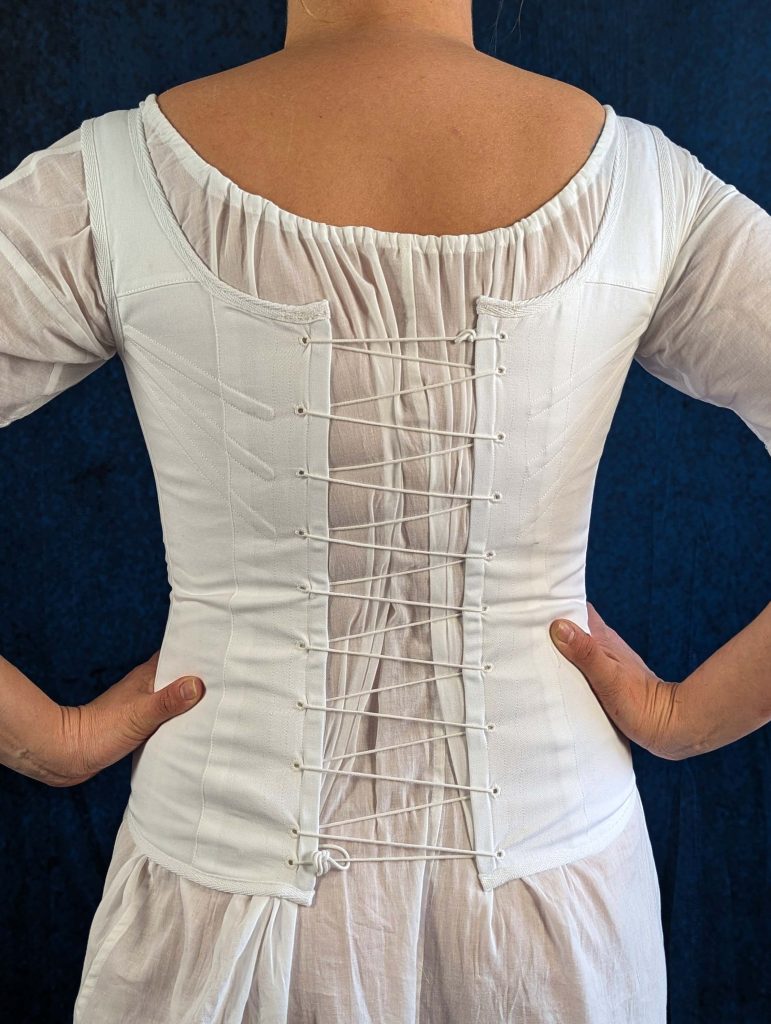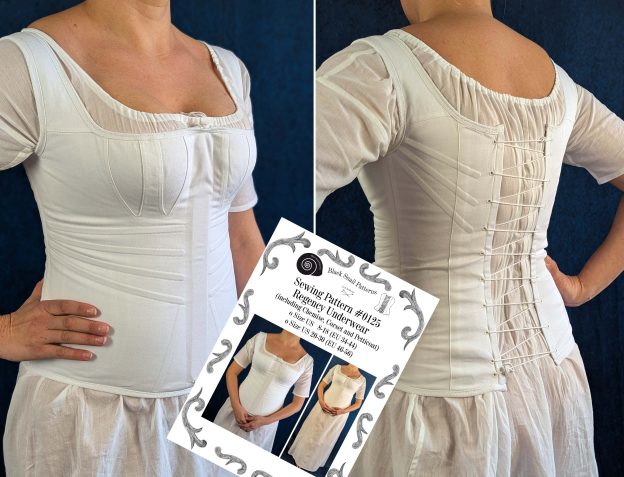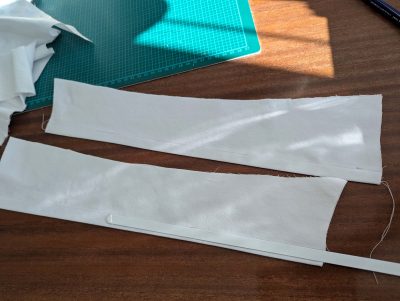The complete Regency undergarment ensemble typically consisted of three key pieces:
- A simple chemise of cotton or linen as the first layer against the skin
- An early corset with less boning than their predecessors, the stays.
- A supporting petticoat that helped maintain the dress’s elegant drape while providing modesty
This blog post is now about the corset construction, again all machine sewing.
The corset in this sewing pattern serves for representations from 1800 to 1820. It is made from two layers of fabric, for the outer layer I recommend a strong cotton fabric like coutil or twill, and the lining can be made from midweight cotton or twill (same as for the top layer). The front (wooden) busk and the boning are introduced between the two layers. The cups will be created by inserting gussets. The lacing at the back still features spiral lacing, with asymmetrically placed grommets.
For an easier and quicker sewing process, the quilting, often seen on extant corsets from that era, will be omitted and the cording will be replaced and imitated by plastic whalebone, inserted in fan-shaped tunnels at the front and back, giving extra support at the underbust and upper back.
The busk has a length of about 13” (33cm) for the smaller sizes and 14” (35,5cm) for the larger sizes. I recommend purchasing a 14” busk and cut to the length needed at home.
(1) Schneide out all pieces from the fabric and lining. Transfer all marks carefully. In this case, I prefer the Pilot Frixion pens for exact lines.
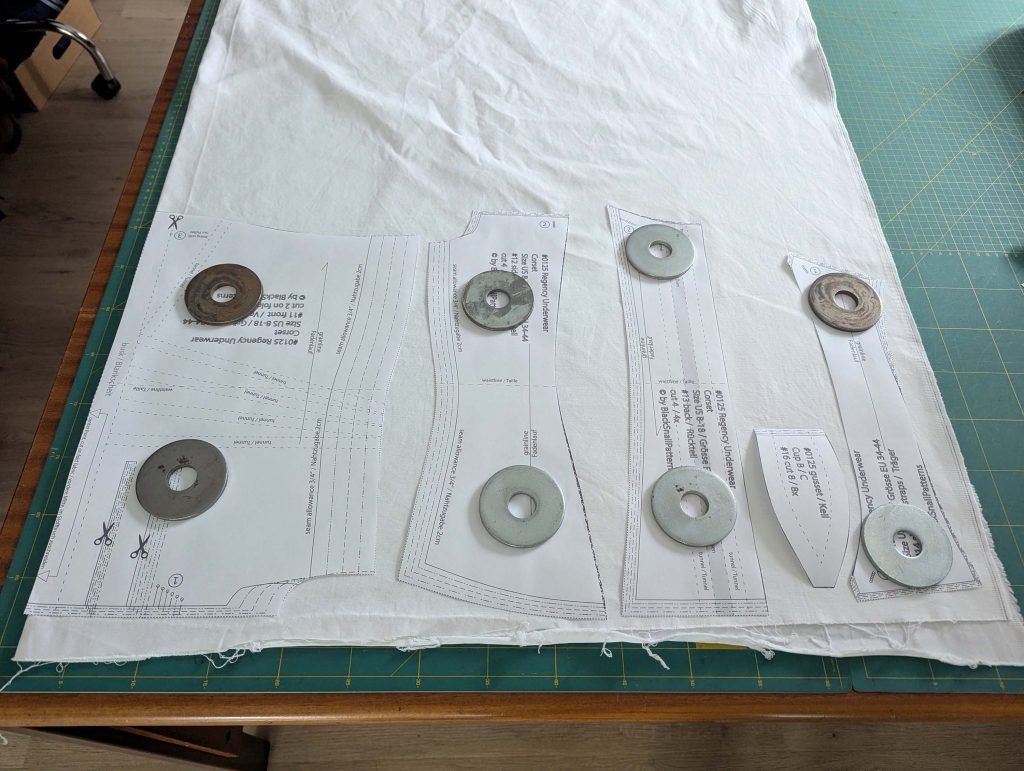
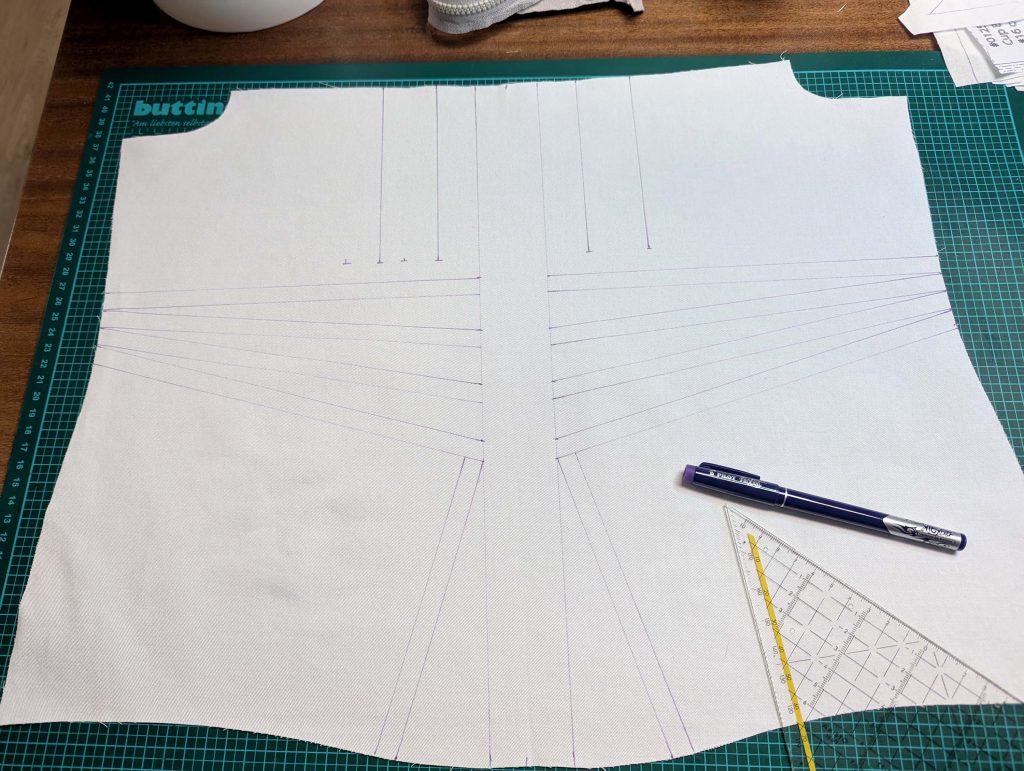
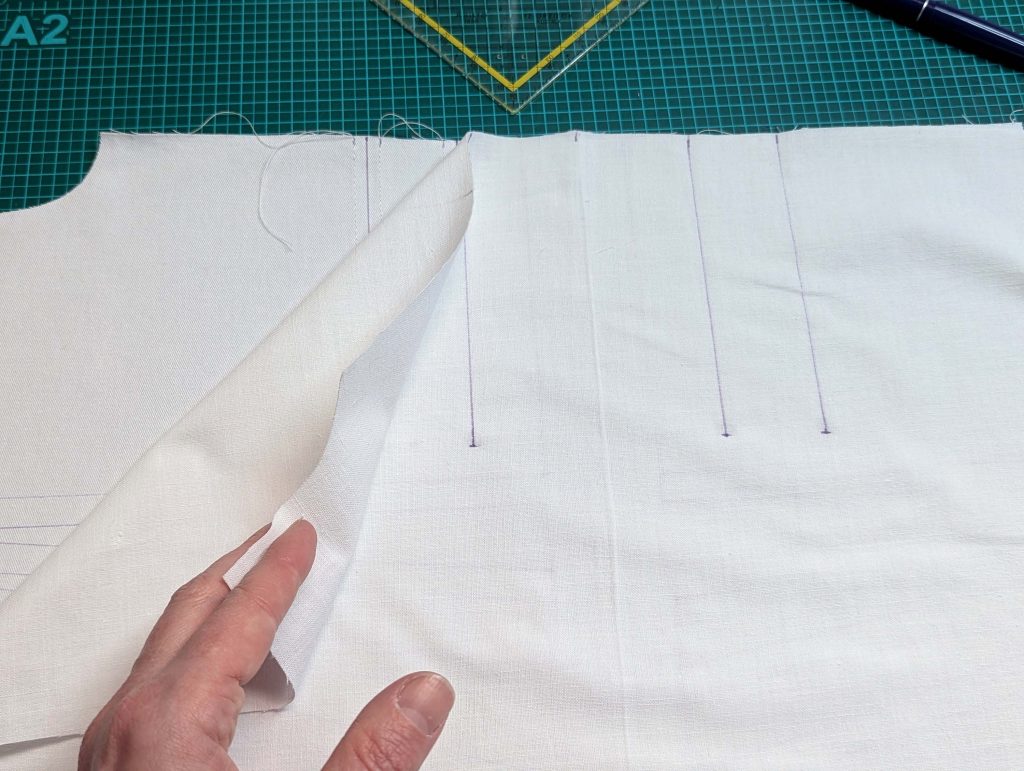
(2) Nimm das Vorderteile from the fabric and lining and insert the gussets. Numerous techniques exist for inserting a gusset into a corset, and I’d like to share my preferred method. Begin by marking the slash lines on the front corset pieces. Starting on the left side of your marking, position your stitching line approximately ¼ inch (0.5 cm) away from the mark, and stitch downward, maintaining this parallel distance. As you approach the end of the slash, about 5/8 inch (1.5 cm) from the bottom, reduce your stitch length and gracefully curve your stitching toward the slash endpoint.
Once you reach the end, pivot your work and mirror these same steps on the opposite side, stitching upward until you reach the fabric’s edge. Apply a drop of Fray-Check at the end of the slash and cut along the line after drying. Fold the seam allowances towards the wrong side along the stitching lines. Sew the fashion fabric and lining separately.
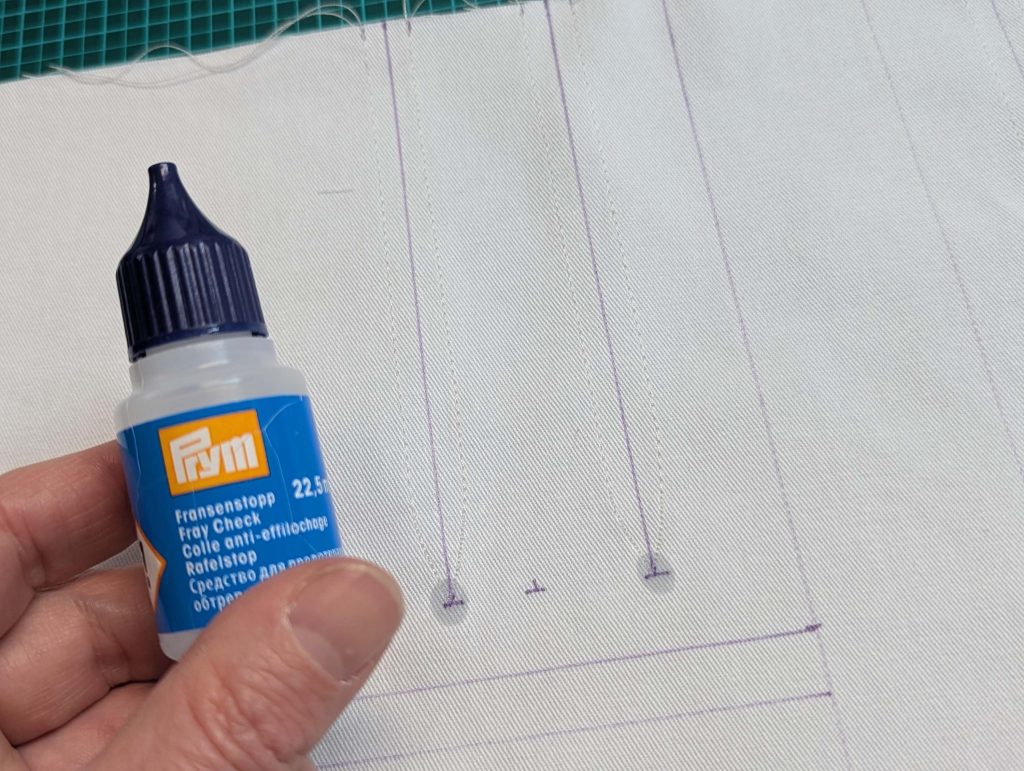
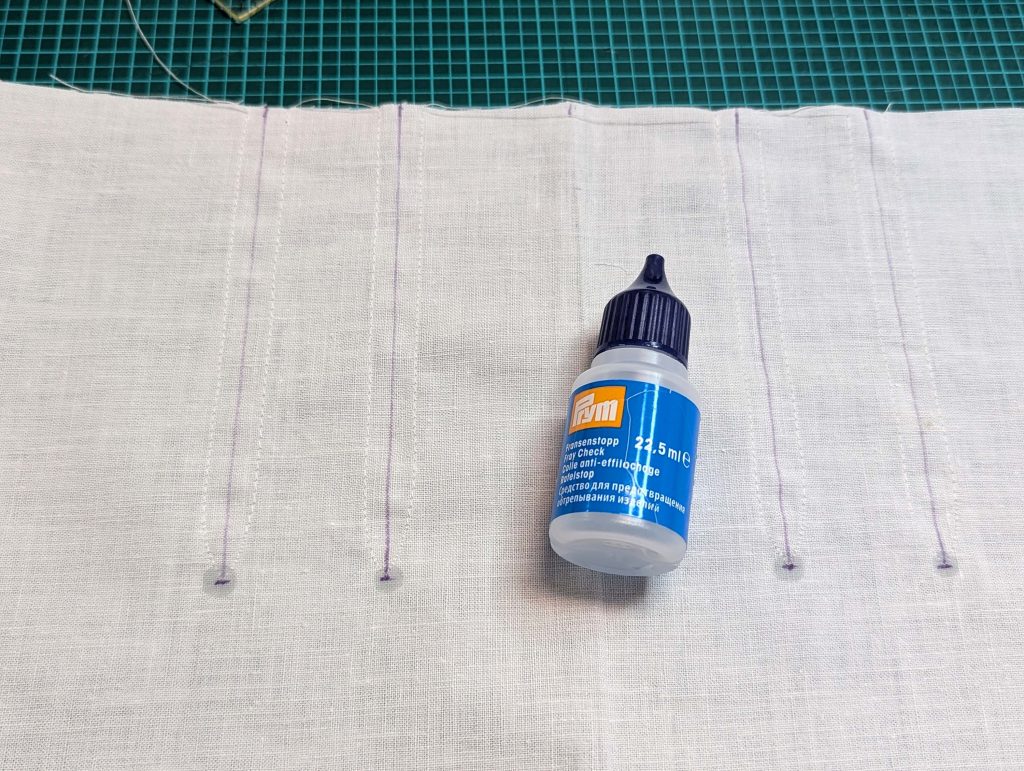
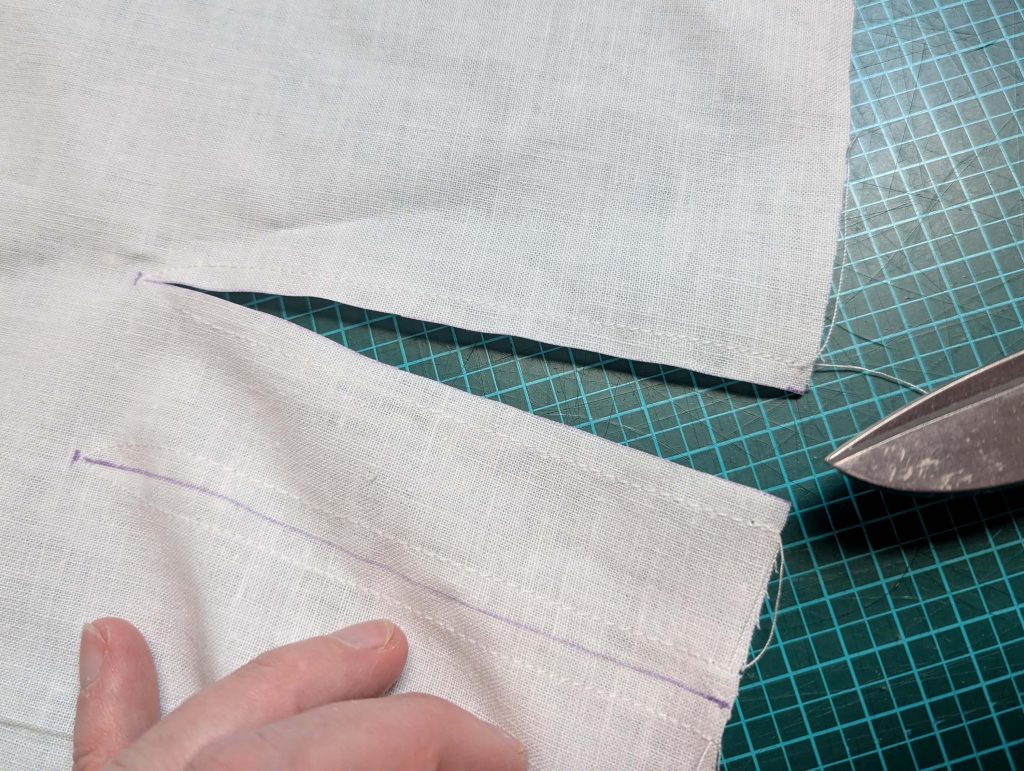
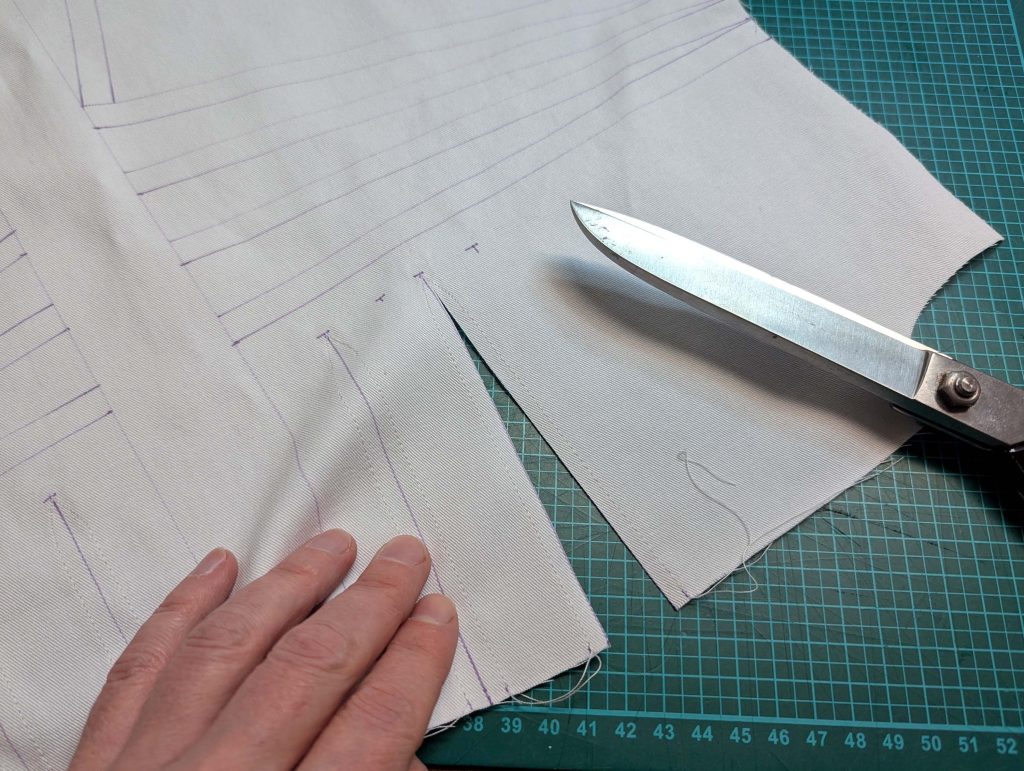
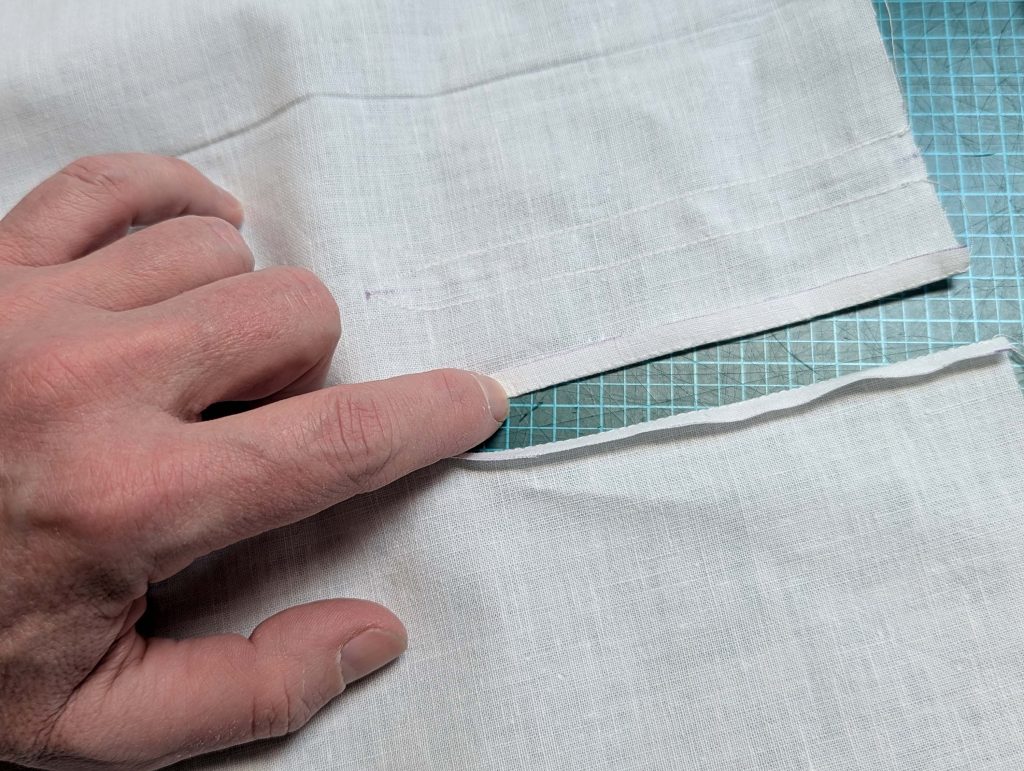
Mark the stitching line on the gusset and align the slash edges with the stitching lines. Stitch in place right beside the edge, pivoting at the end. If wanted, make a second stitching row parallel to the first. Repeat all steps on the lining separately. Optionally, bar tack the end of the gussets on the finished corset.
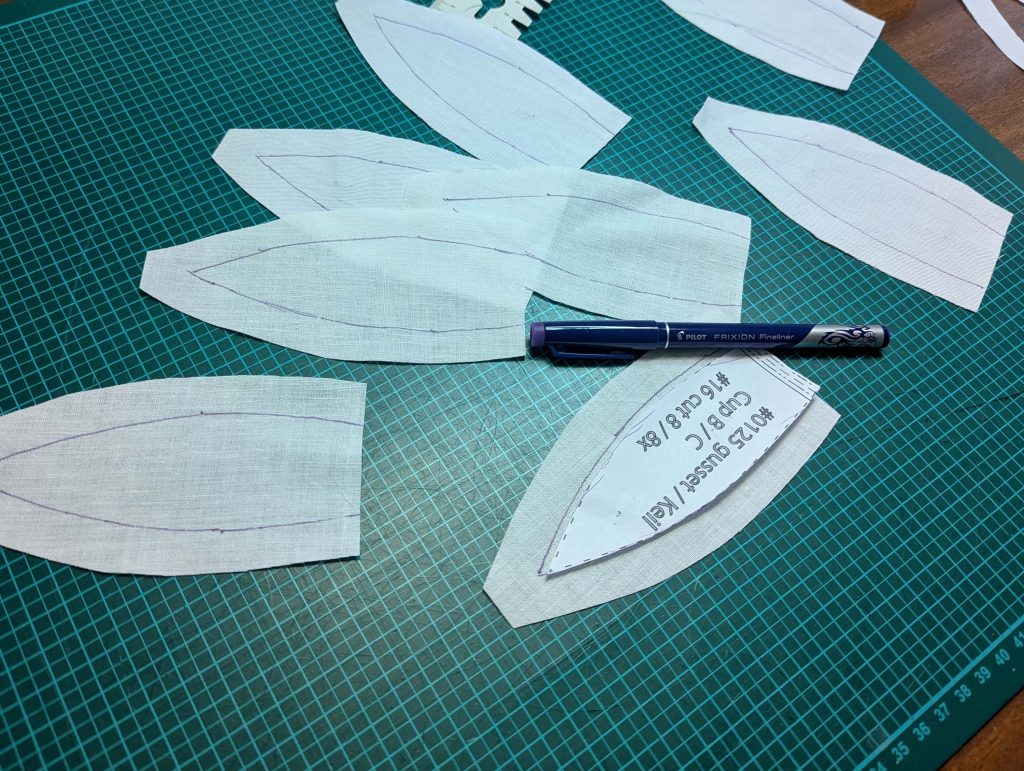
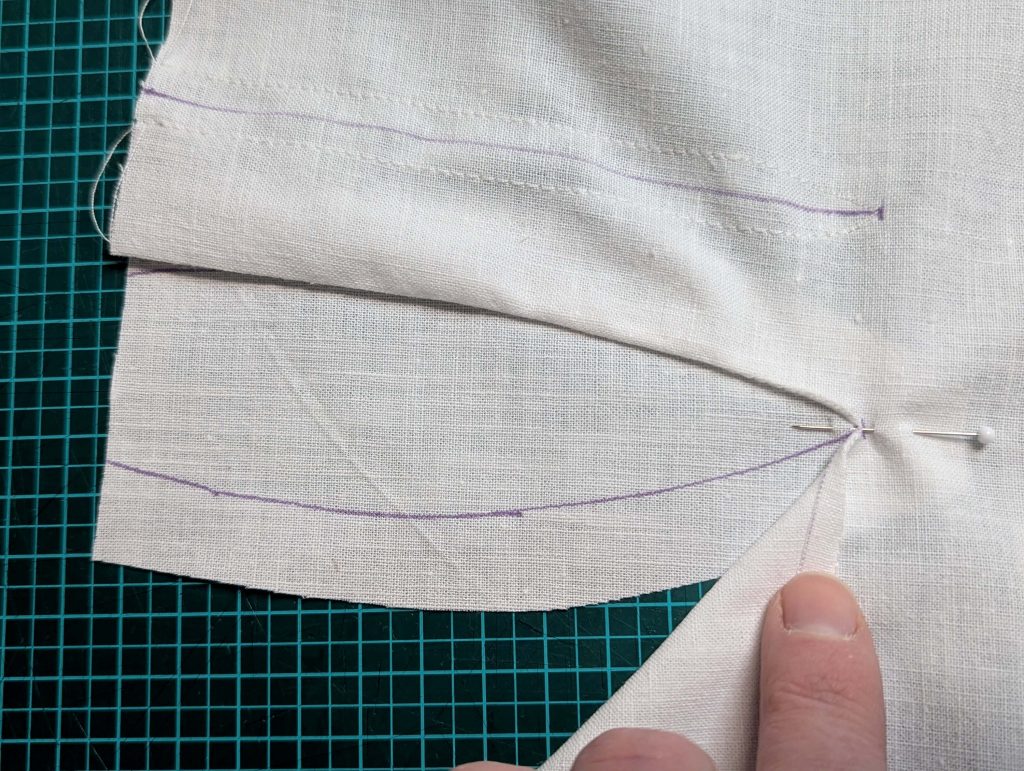

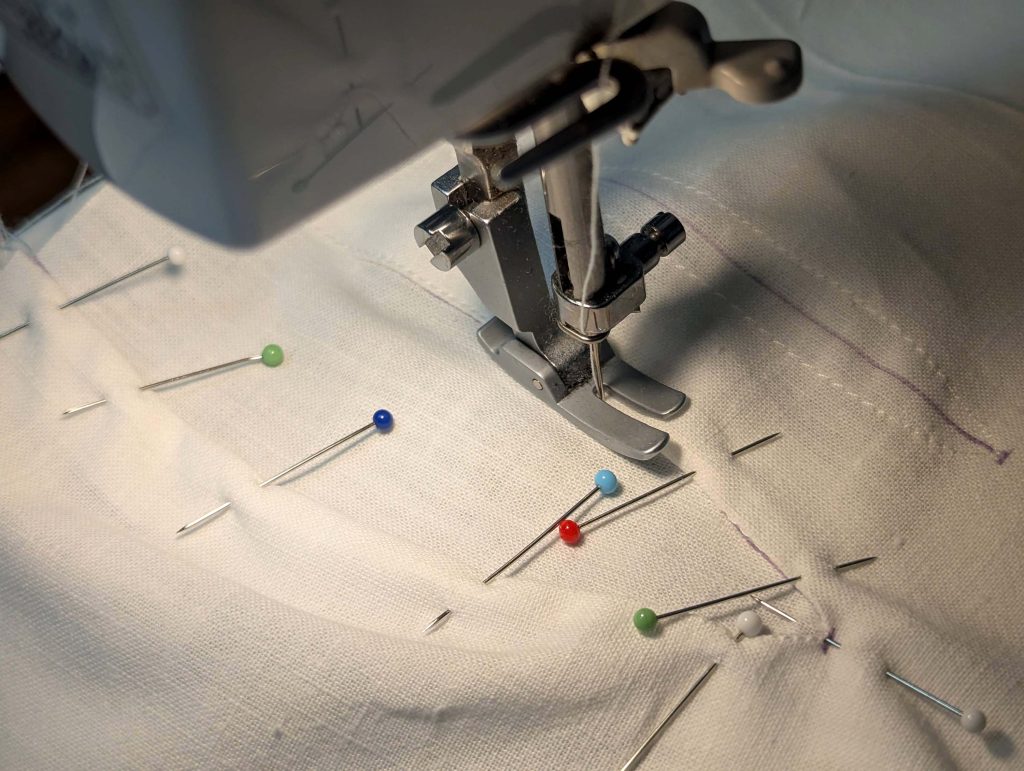
Line up the fronts from the fashion fabric and lining, wrong sides together, matching the gussets. Line up the gussets exactly, first baste, then stitch together the layers in the ditch of the gusset from the right side. OK, you know me, I like to omit the basting and sew just with the layers pinned together.
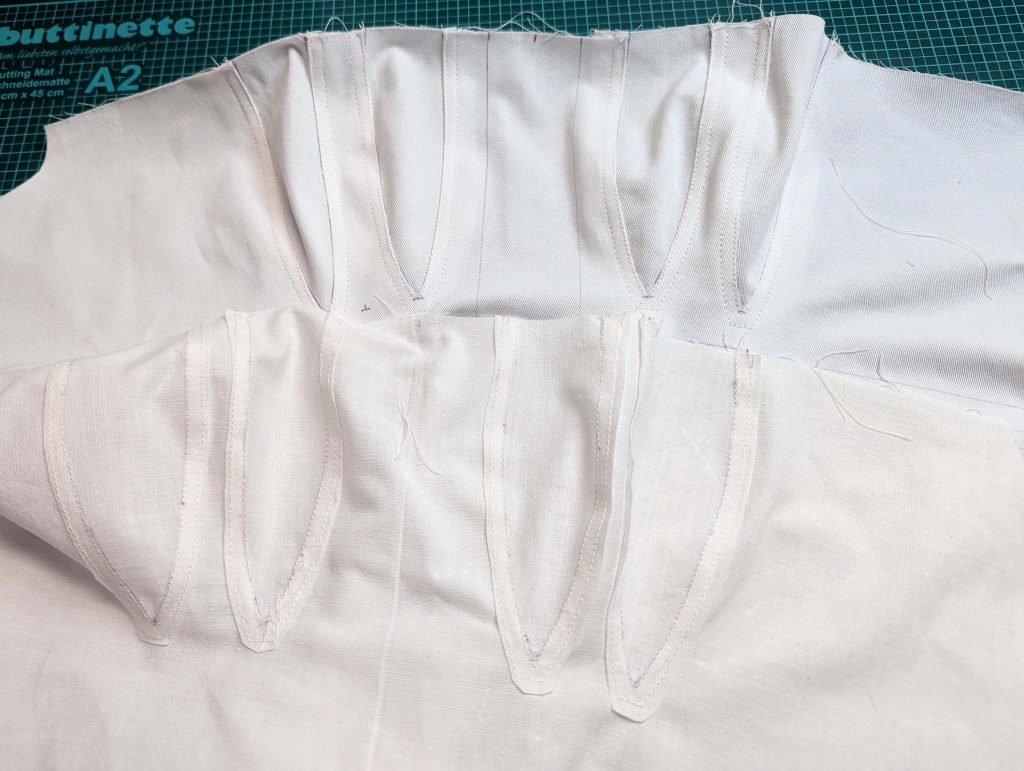
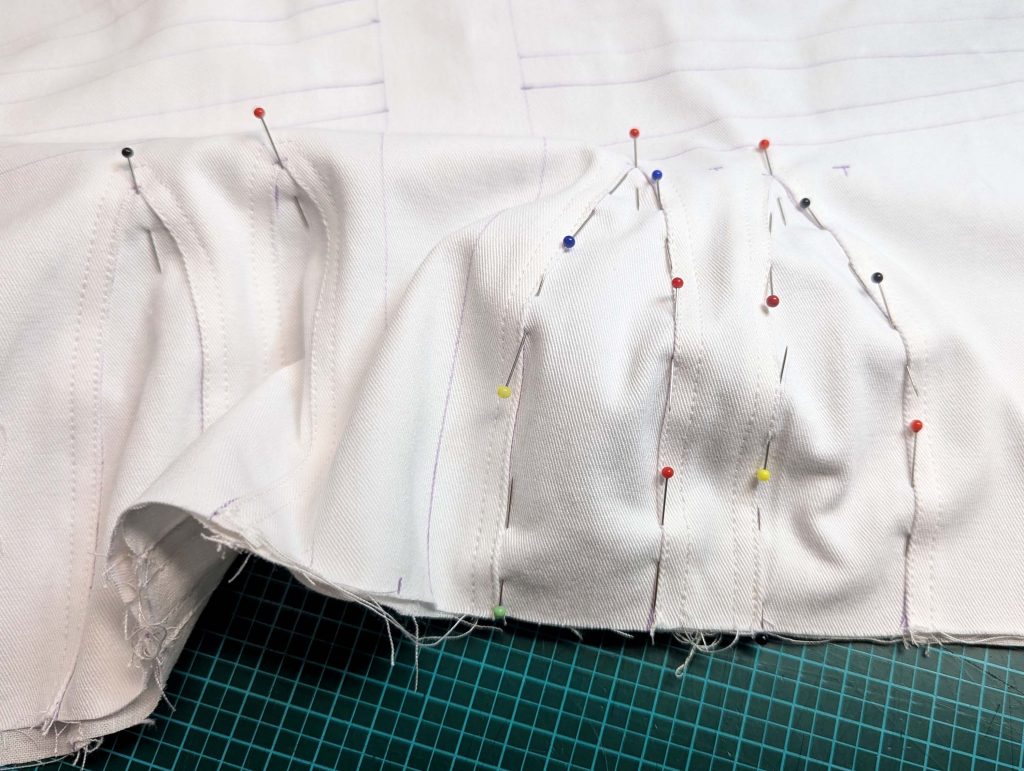
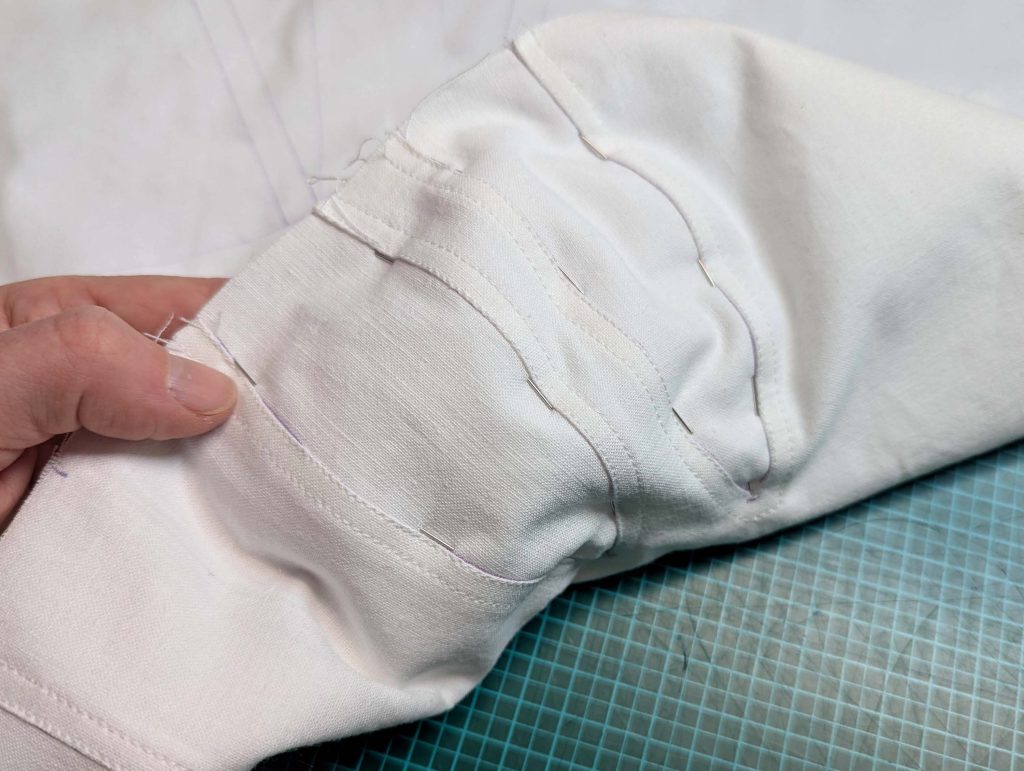
Stitch the tunnels, first the tunnel for the busk, followed by the tunnels for the plastic whalebone, try to stitch the underbust tunnels in one go. Cut the whalebone to the length needed and insert it into the tunnels, take care to leave enough space at the side seam, seam allowance is ¾” (2cm) here.
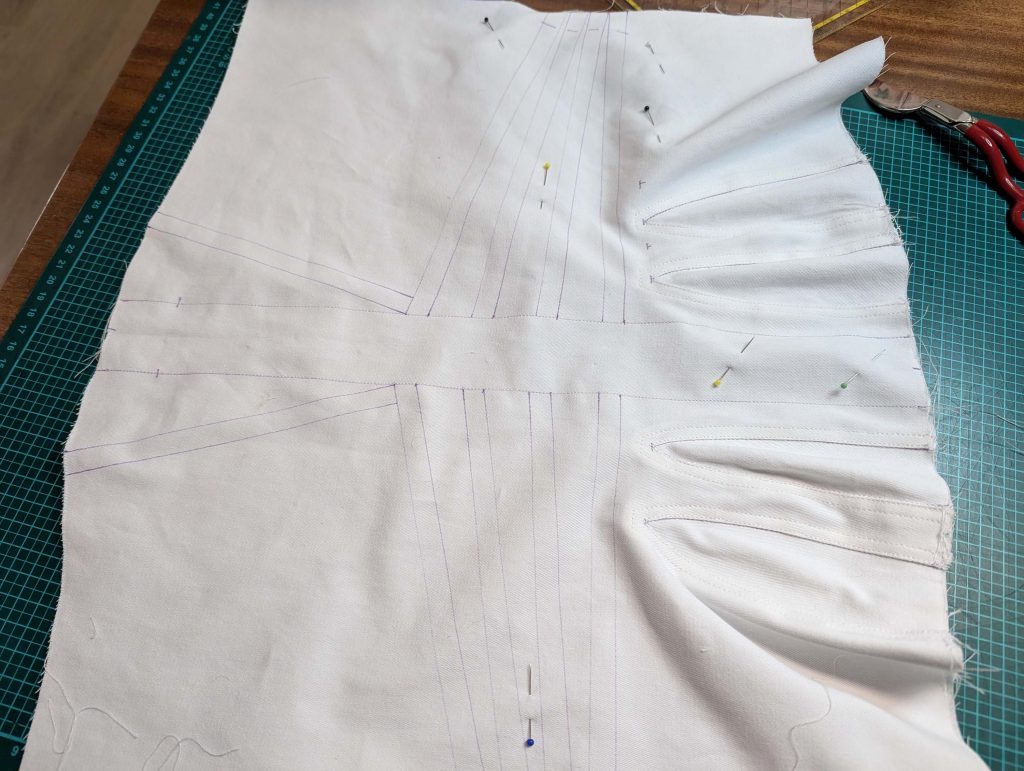
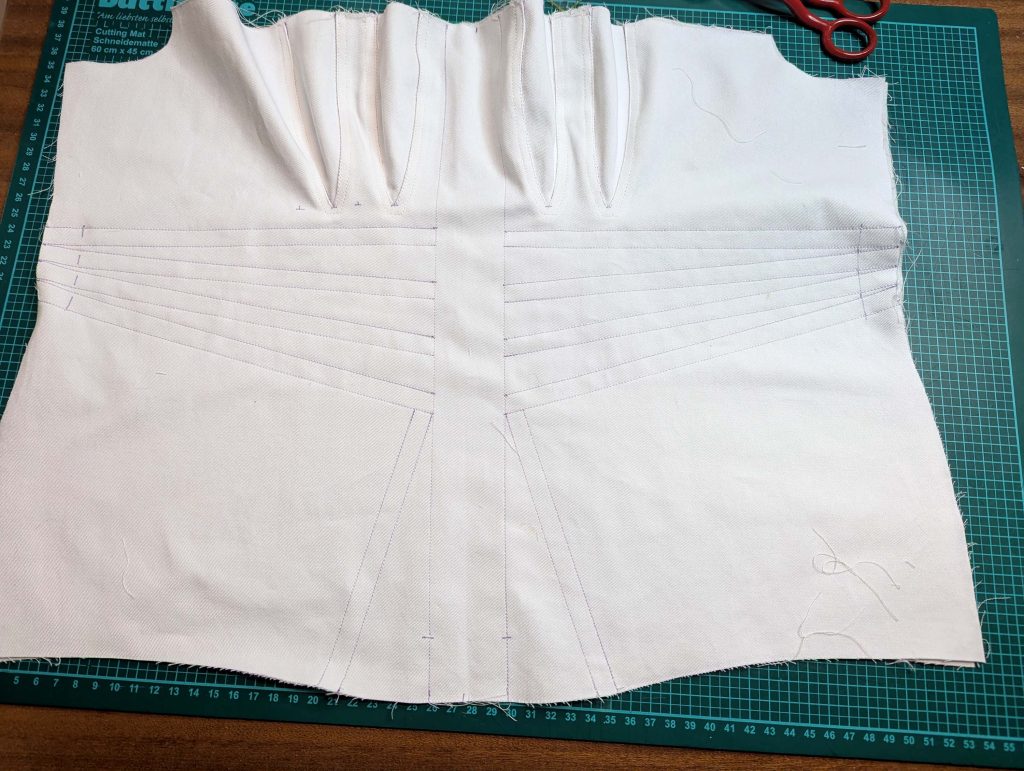
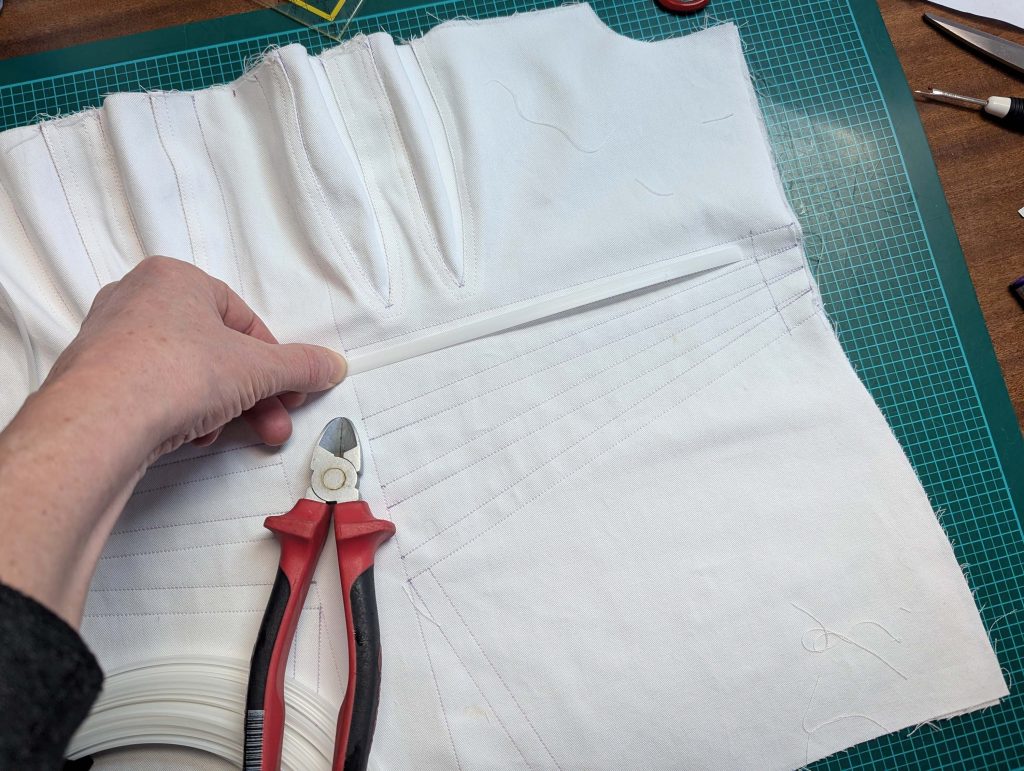
Time to press the garment, this will remove any of my pen markings and also help to shape the plastic boning straight again.
(3) Näh das Rückenteil rechts auf rechts auf das seitliche Rückenteil, right sides together, press the seam allowance towards the back, and topstitch from the right side. Repeat with the lining. Line up the top layer with the lining, right sides together, and sew along the back edge, with the lining protruding the fashion fabric for about 1/8″ (2-3mm) for the turn of cloth. Fold the seam allowance towards the lining and understitch. Fold the layer’s wrong sides together and press the edge, rolling the stitching slightly out of sight towards the garment’s wrong side.
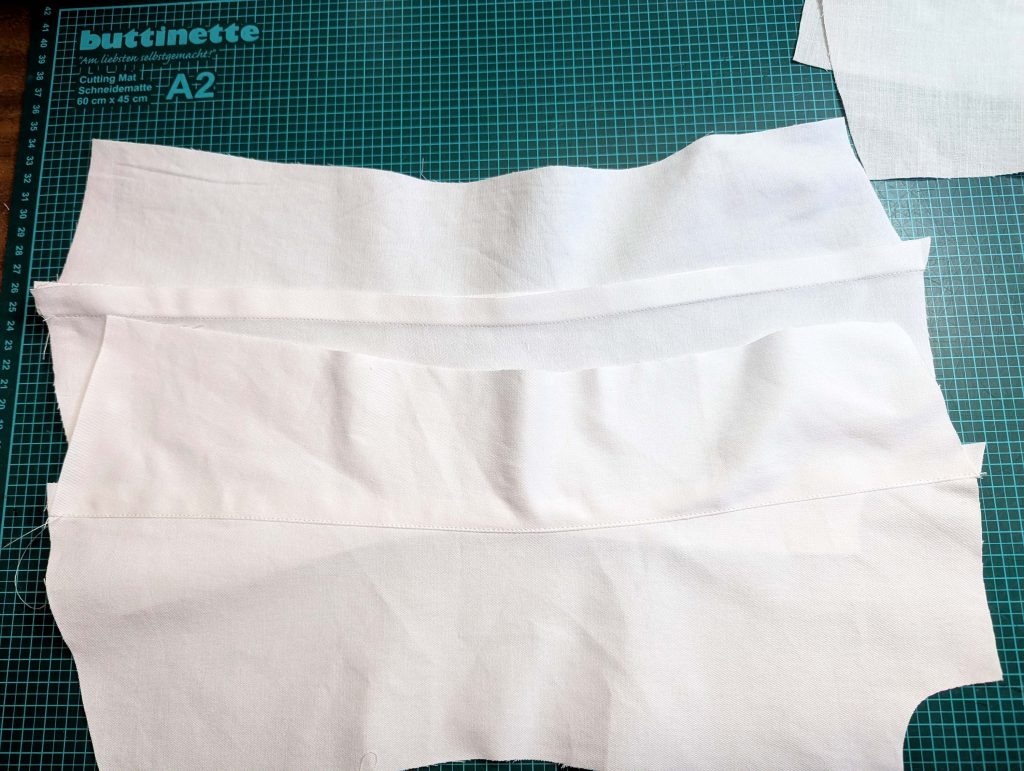
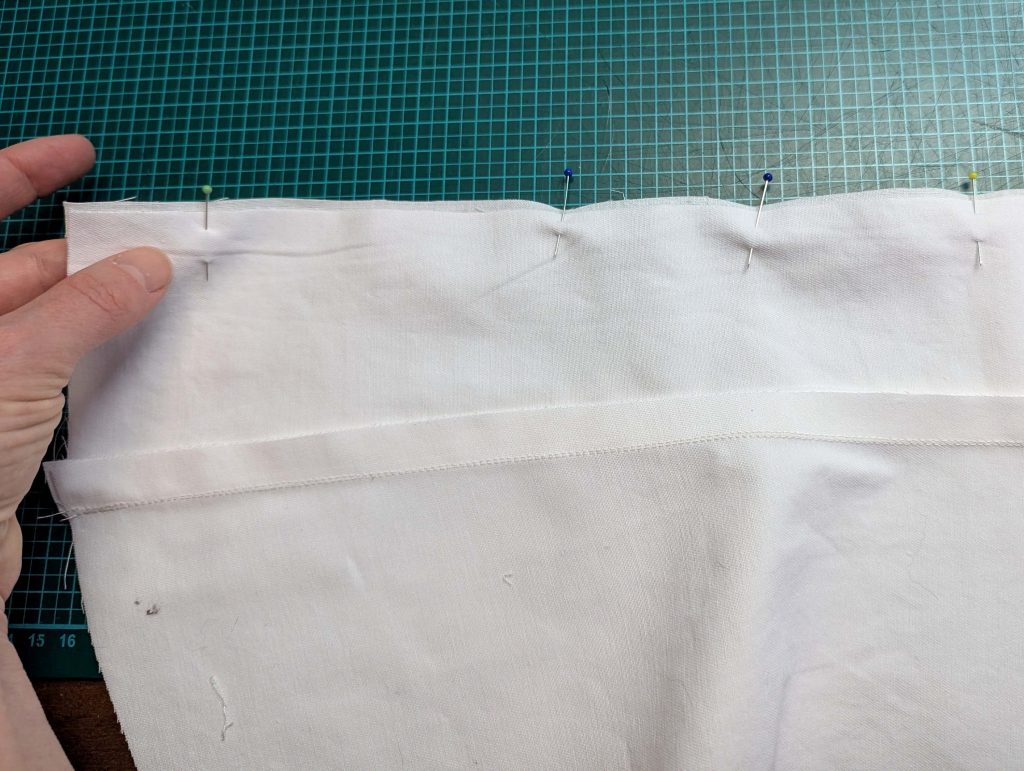
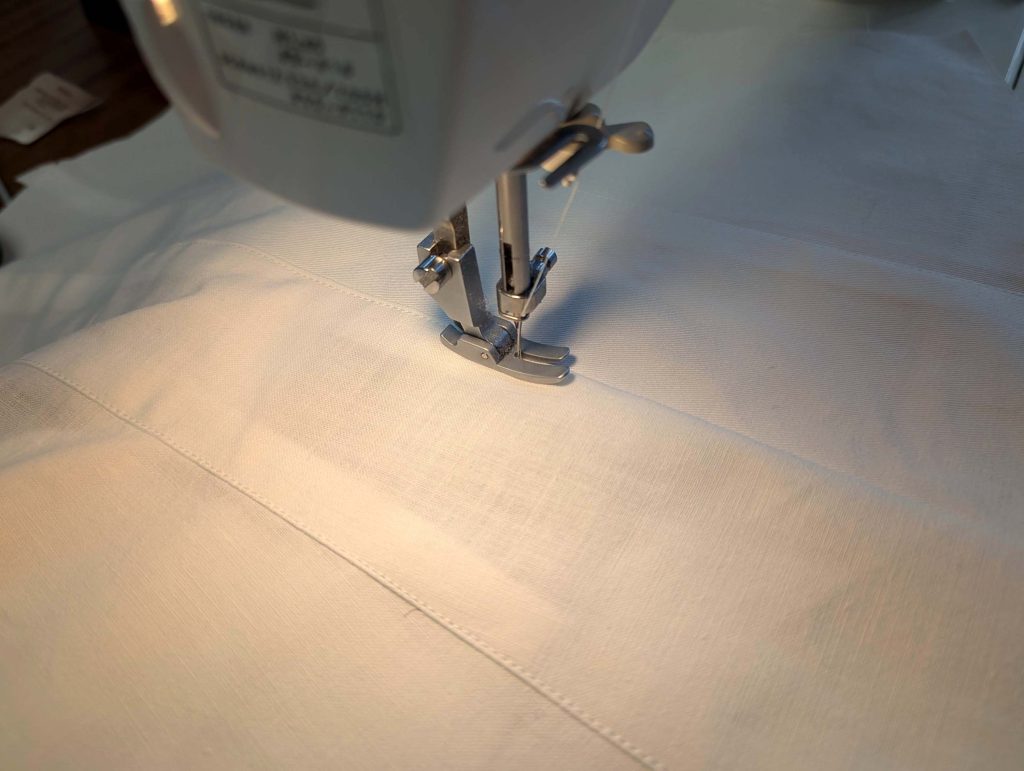
Näh das strap to the side back, right sides together, and stop at the mark (2). Trim back the seam allowance, and angle at the mark. Press the seam allowance towards the straps and topstitch. Sew the fashion fabric and lining separately.
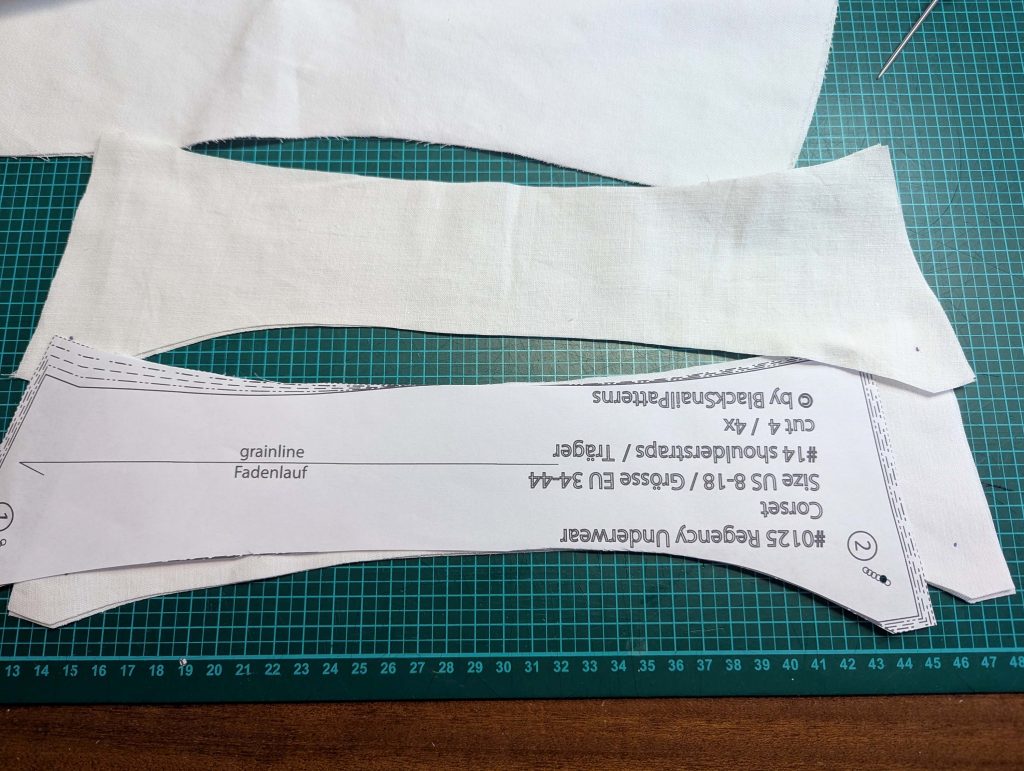
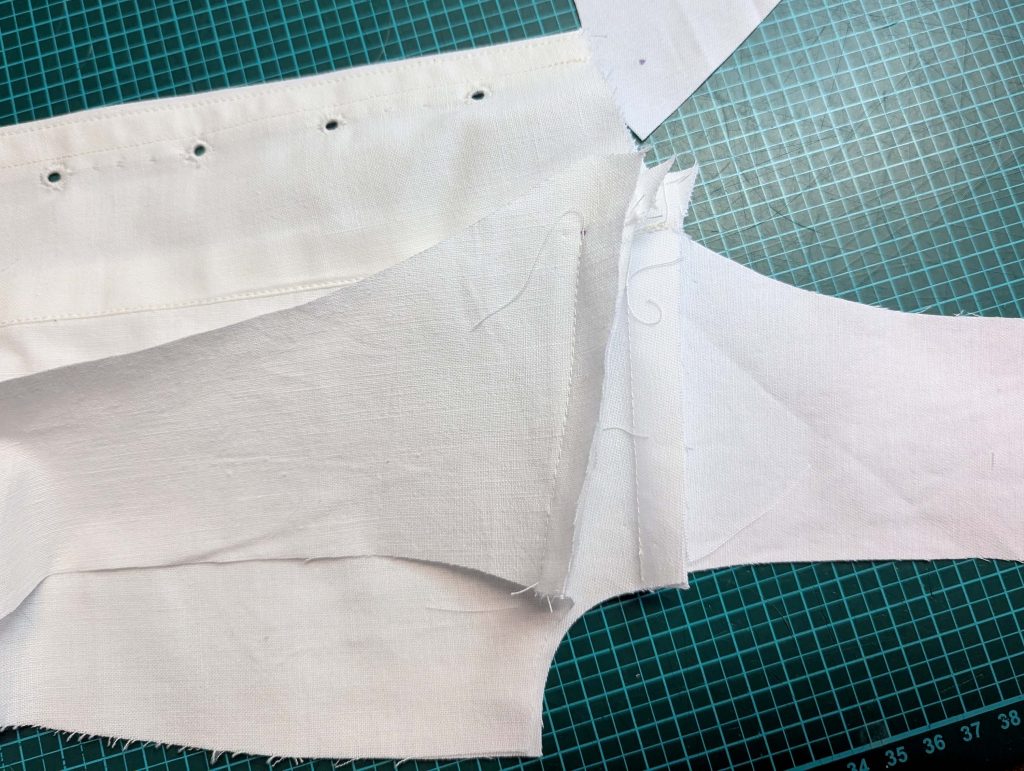
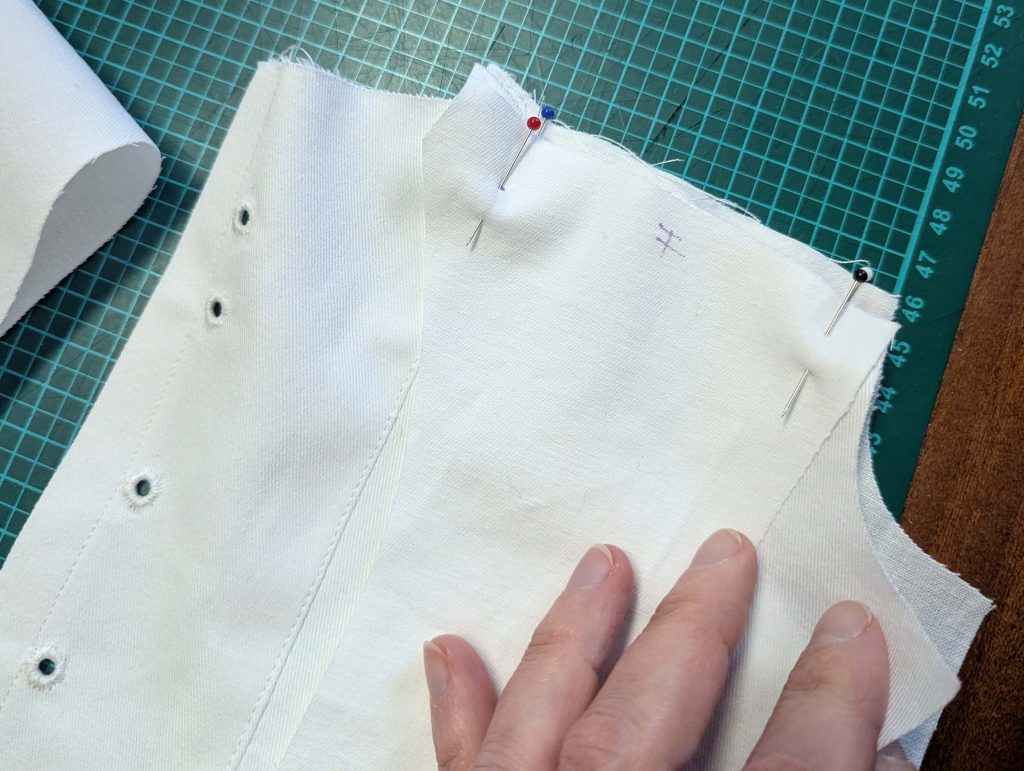
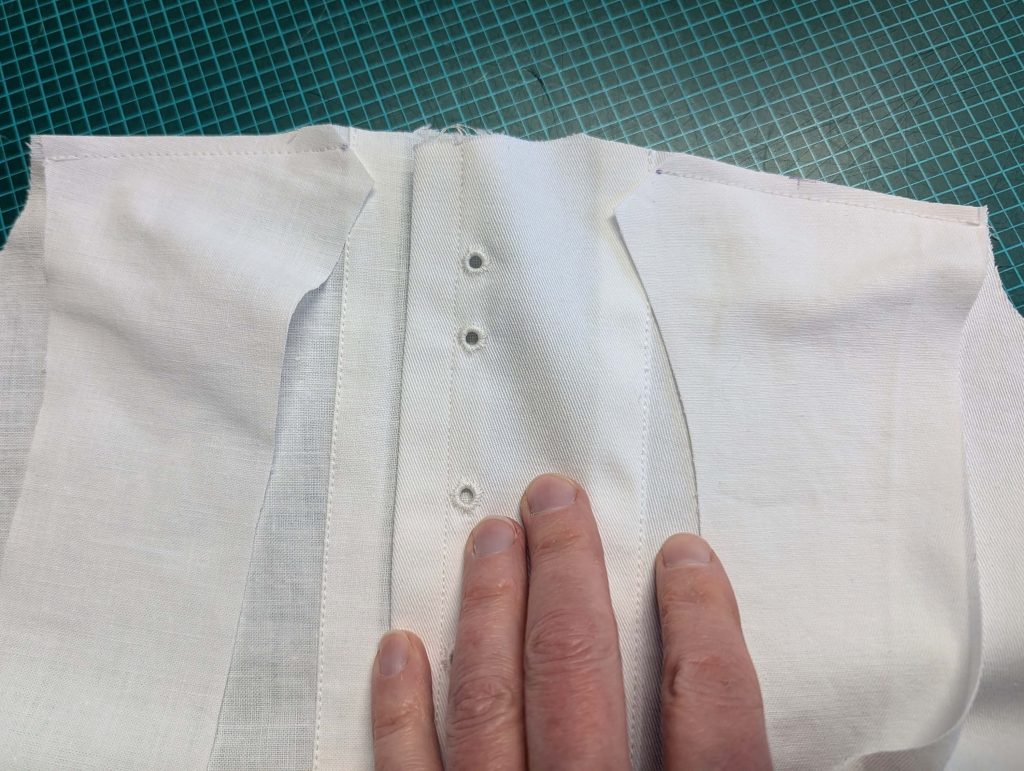
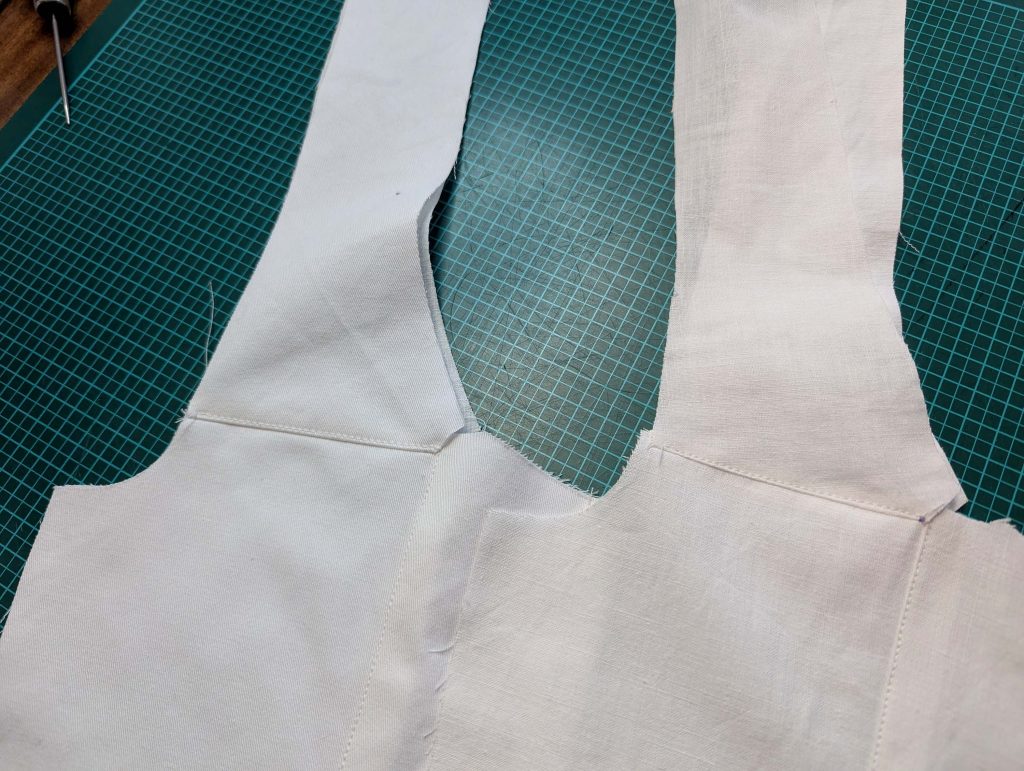
(4) Näh das seitliche Rückenteil rechts auf rechts auf das Vordertteil – ¾” (2cm) seam allowance, right sides together. Fold the lining of the side back to the side, but catch the front lining together with the fashion fabric. Press the seam allowance towards the back. Smooth out the back lining, turn in the seam allowance along the side seam, cover the raw edges, and protrude the stitching line about 1/8” (3mm). Baste in place, and topstitch from the right side, catching the lining on the back.
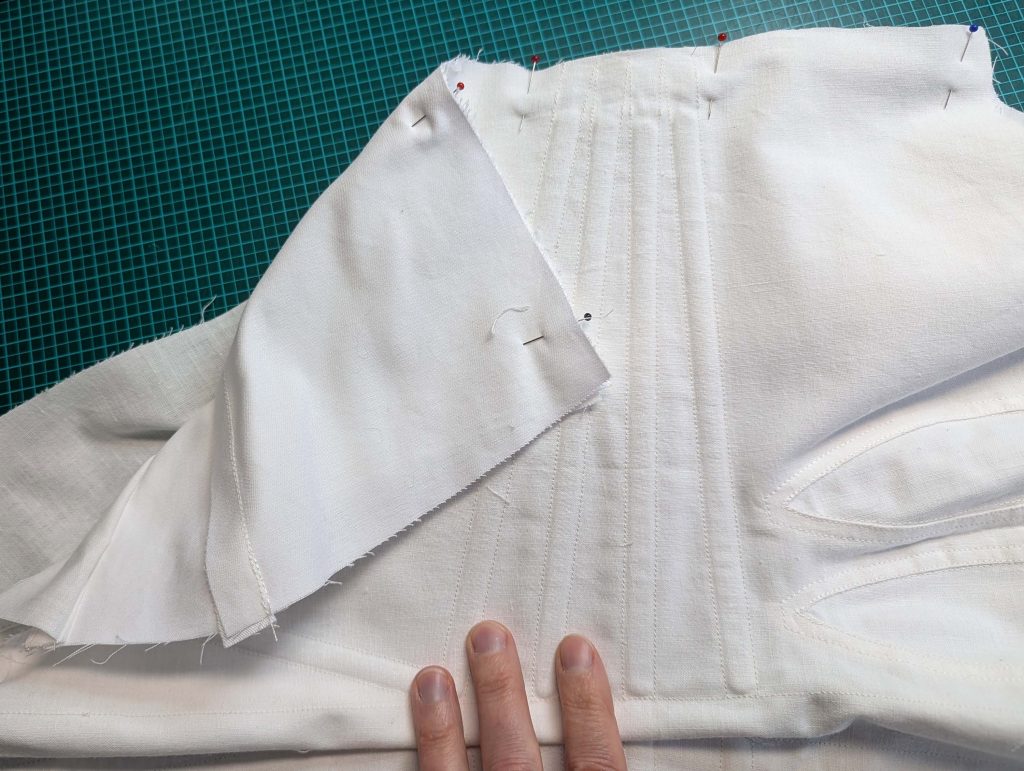
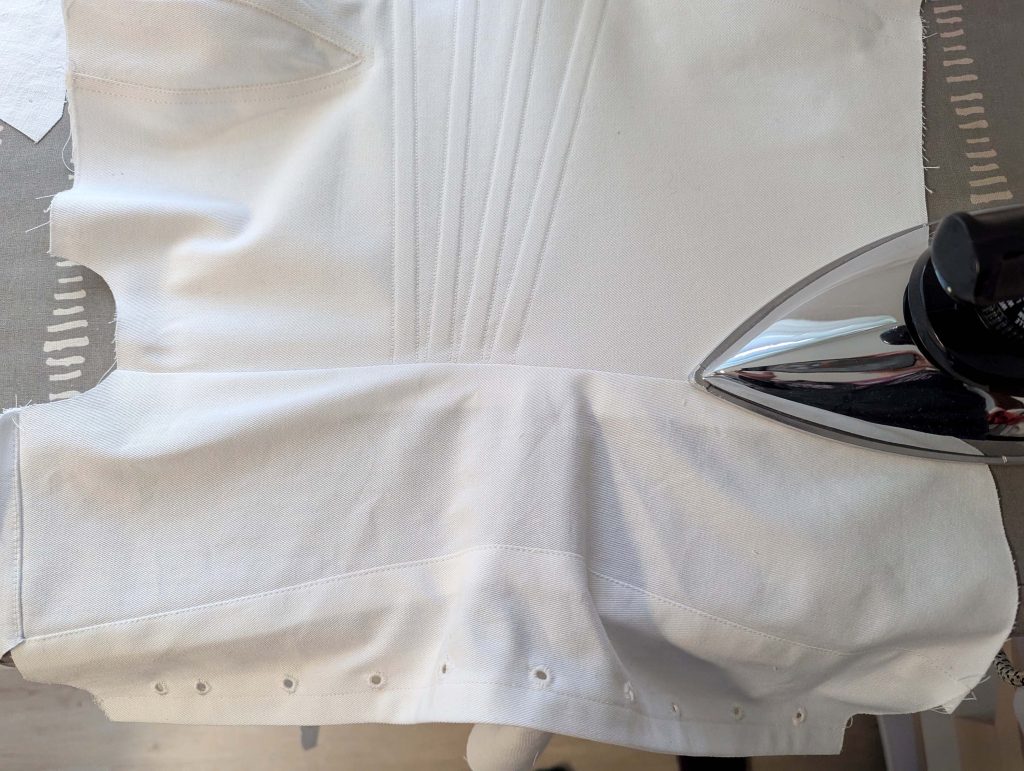
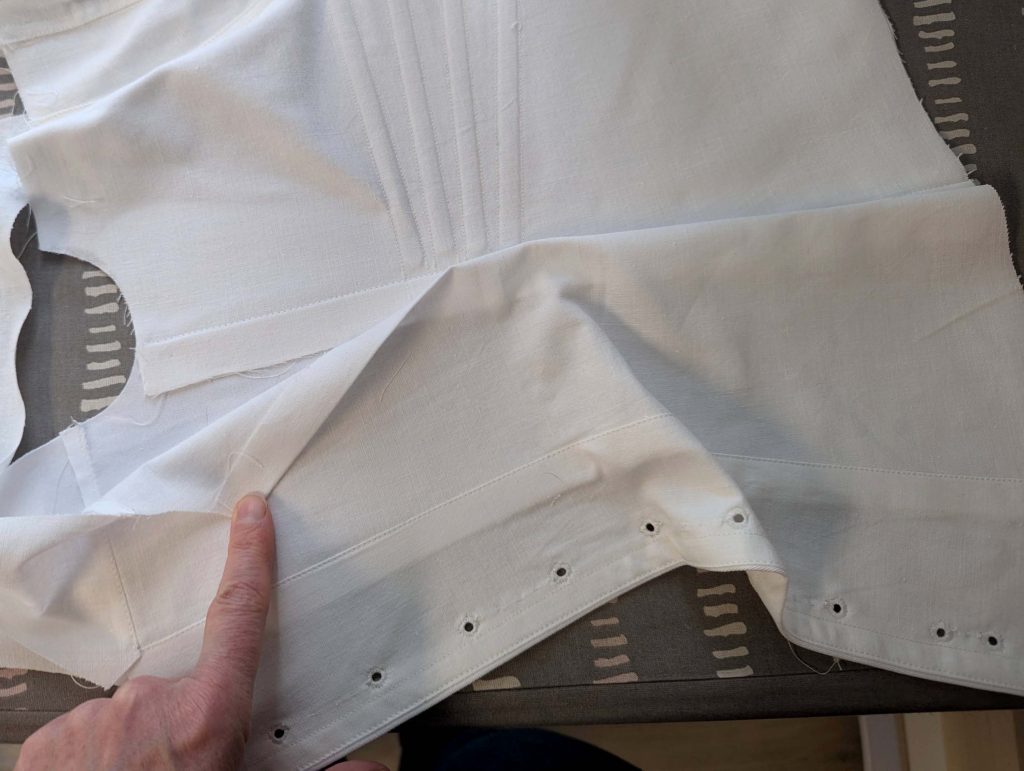
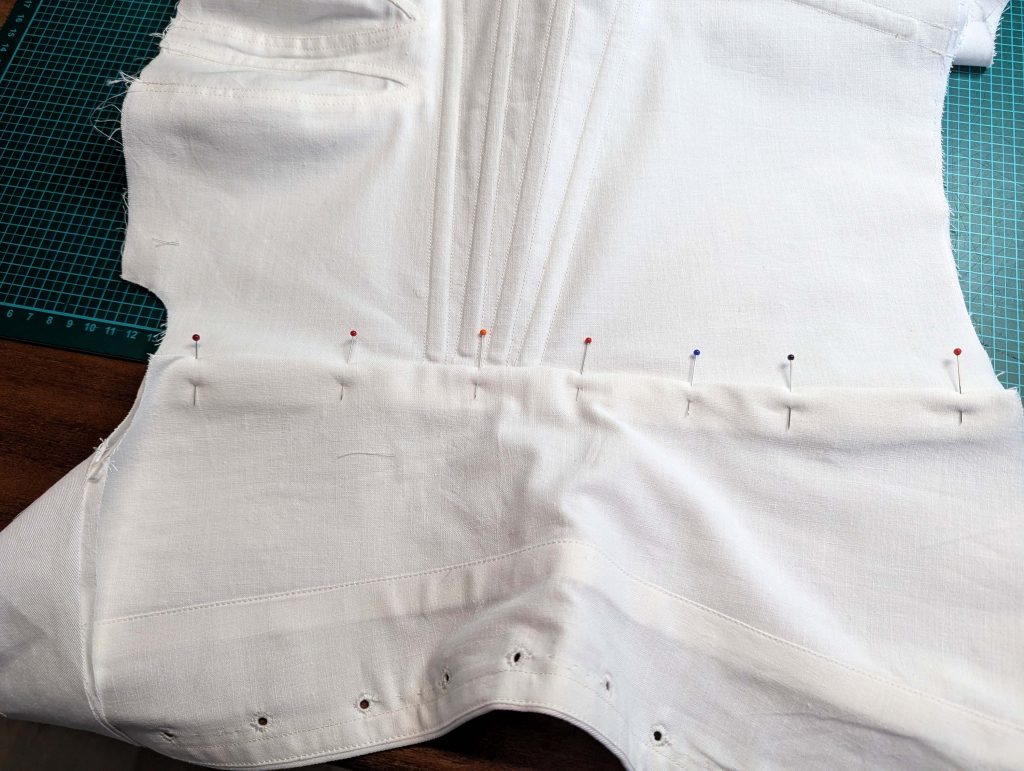
(5) Nähe tunnels for the boning along the back edge, and along the side seam, the width depends on the width of your boning. For the larger sizes, I recommend a second row of boning along the back, right beside the grommets.
Sew eyelets or insert metal grommets, taking care of the asymmetrical positioning for the spiral lacing. For the eyelets, mark the position and punch a hole with an awl. Widen the hole with a larger knitting needle, without damaging any threads. Take your double-threaded needle and knot the end of the thread. I prefer the way to double thread the needed as shown, and to wax my thread for eyelet stitching for a smoother finish.
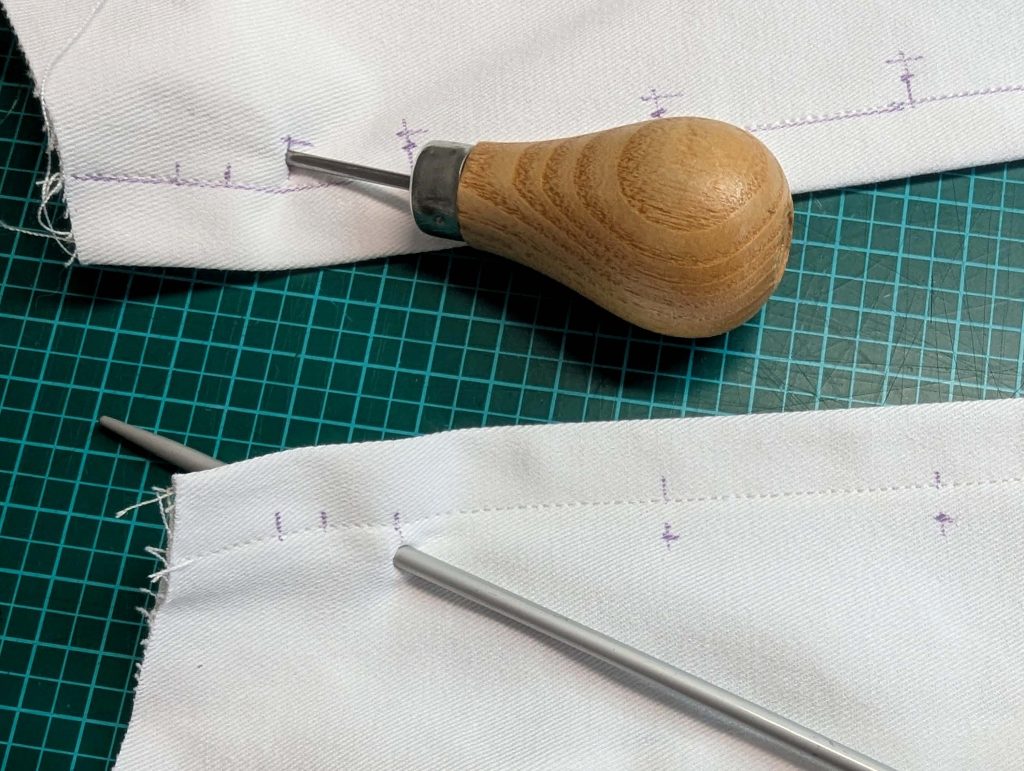
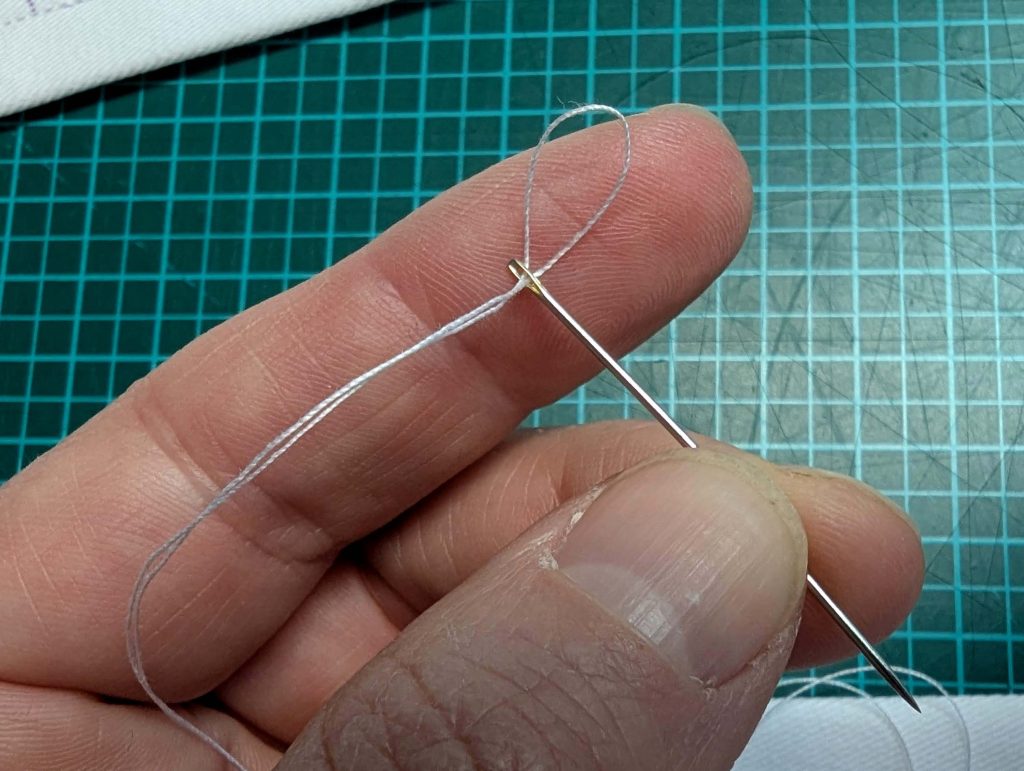
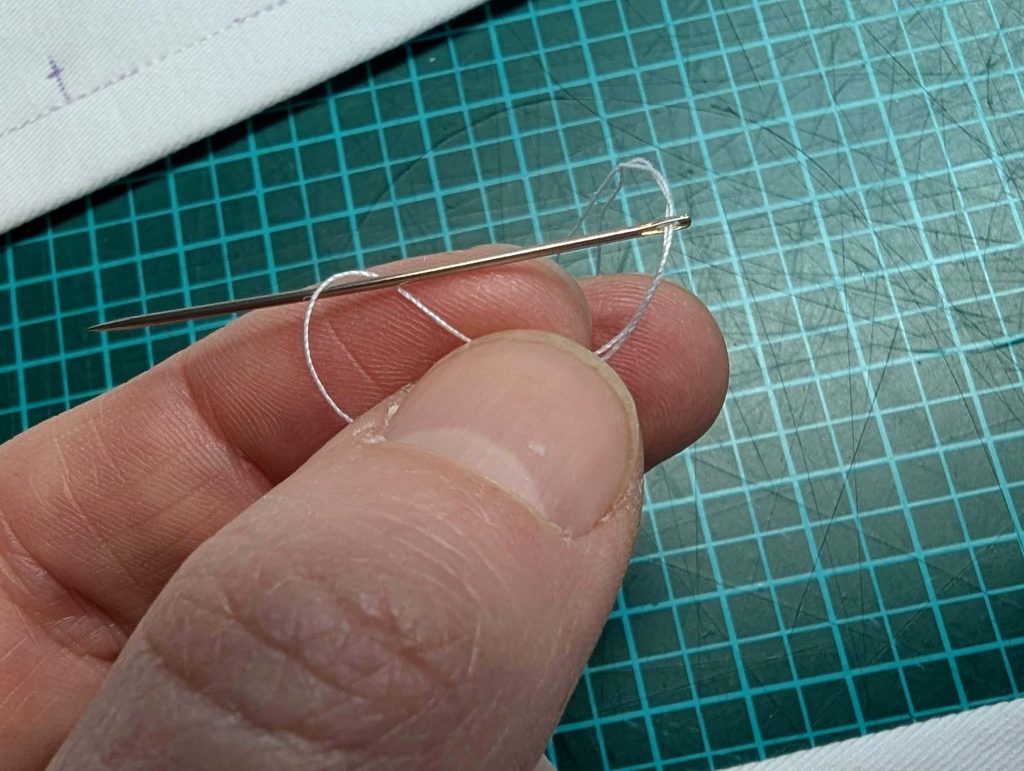
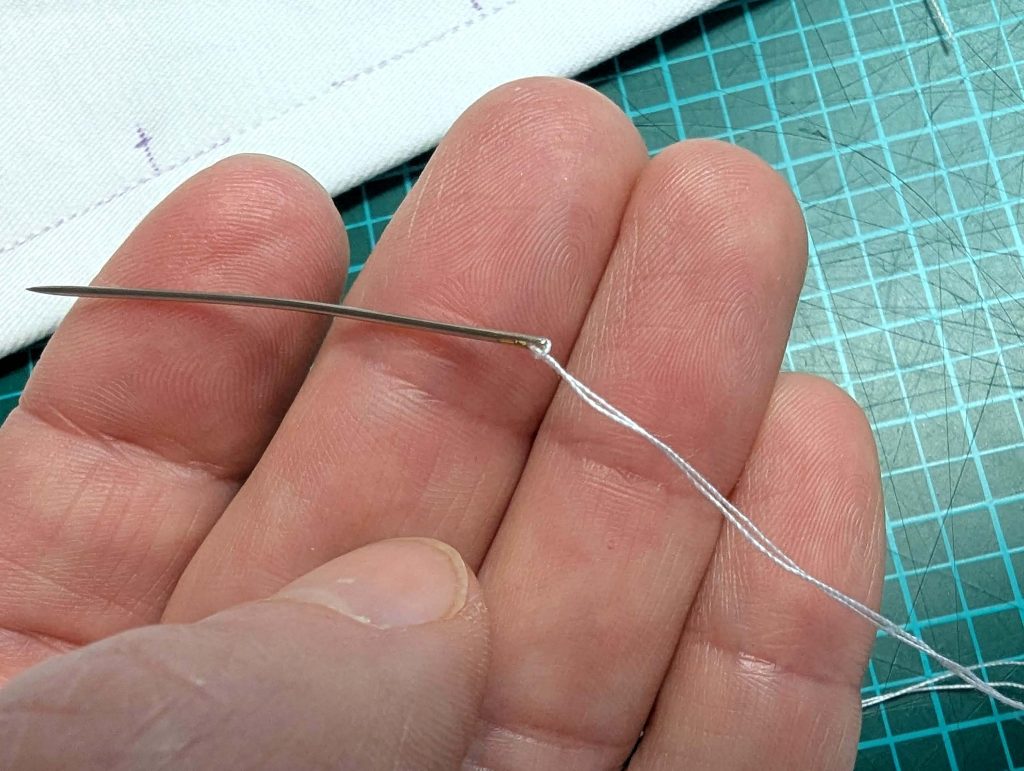
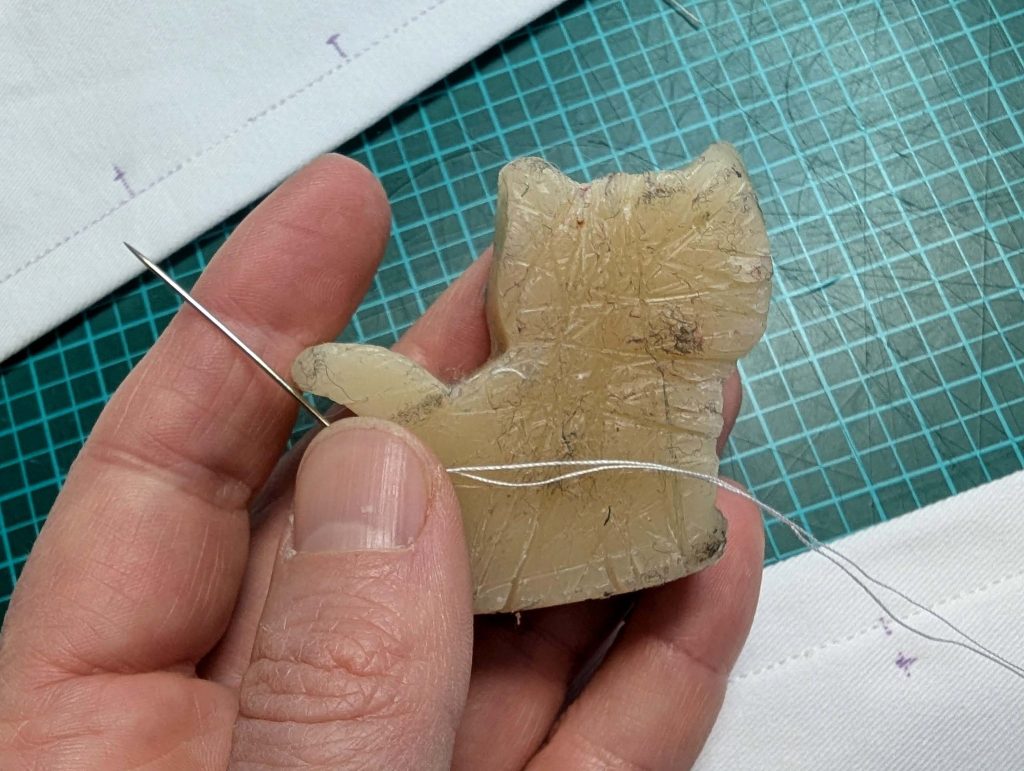
Make the first stitch near the hole on the wrong fabric side, secure with 2-3 stitches, and bring the needle through the fabric to the right fabric side. Start with four stitches at an angle of 90°, pulling the thread quite tight to hold open the hole. Before starting with the whip stitches, going all around, widen the eyelet again with the knitting needle. Secure the thread on the wrong side. “Walk” to the next eyelet when your thread is still long enough.
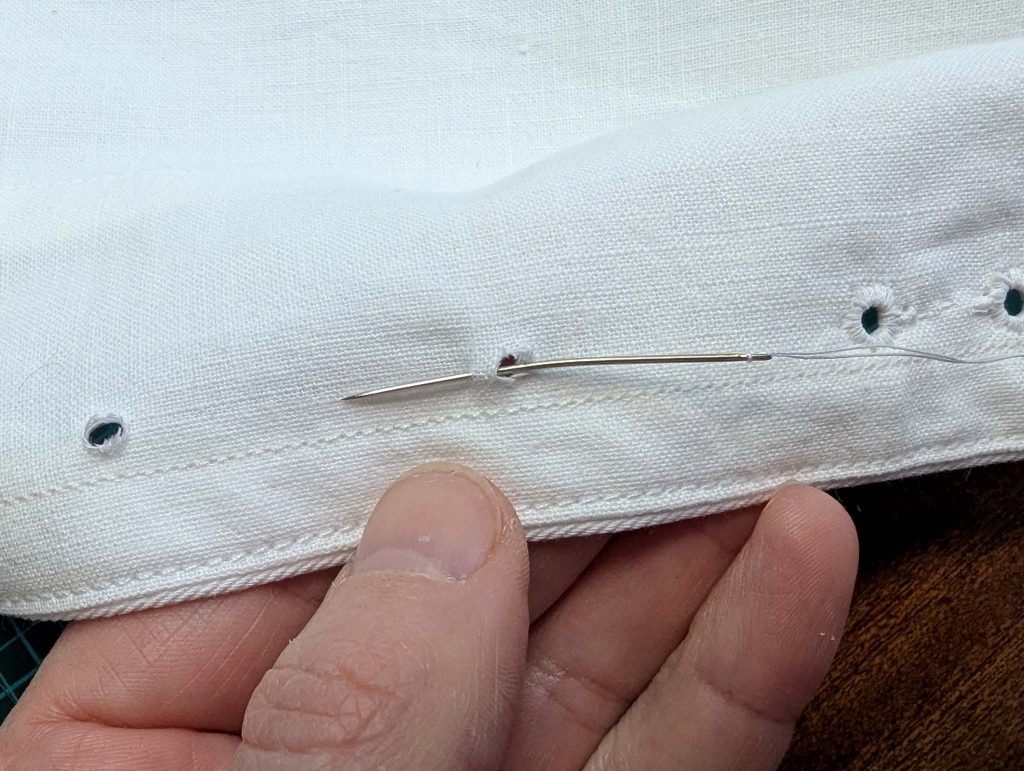
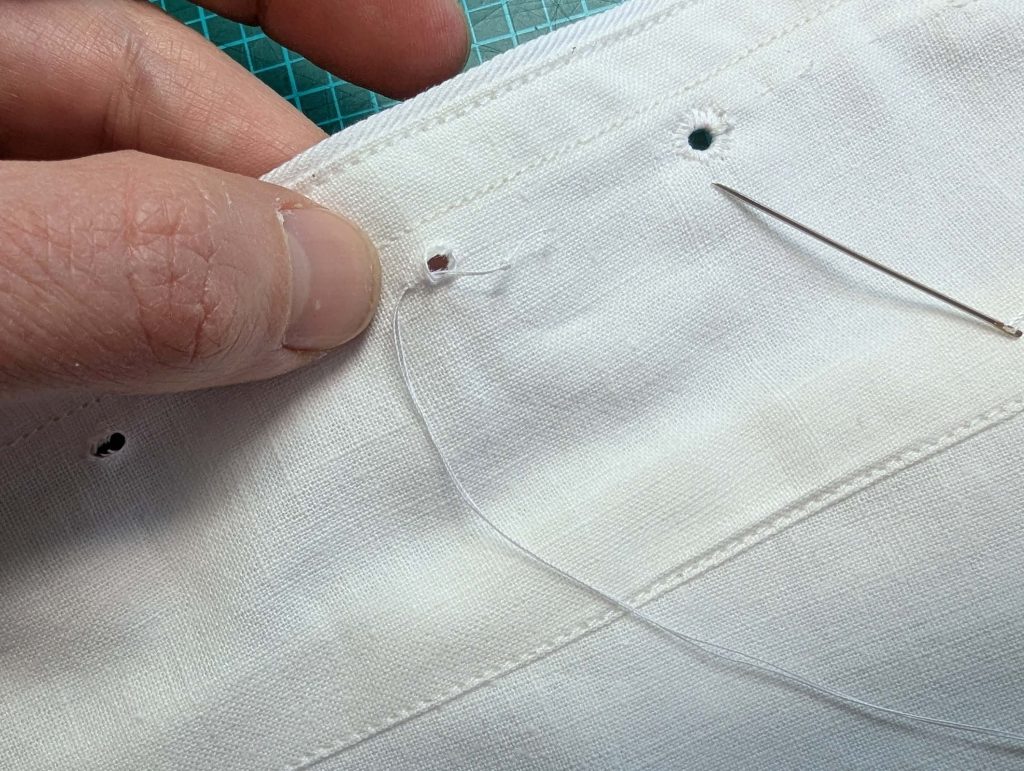
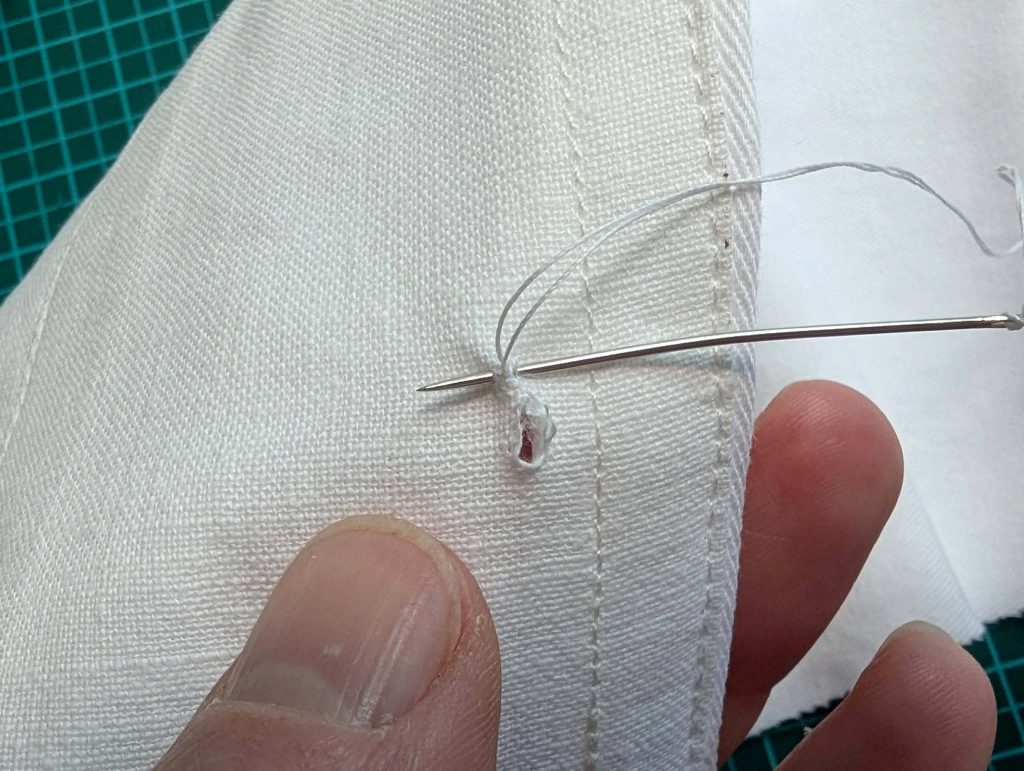
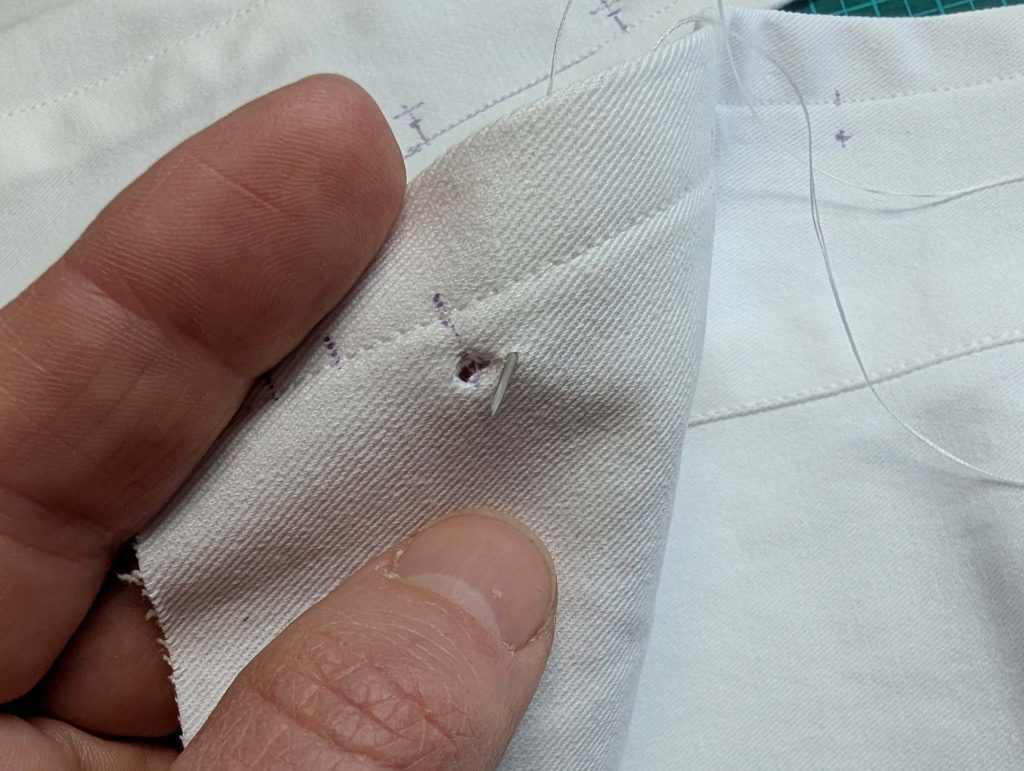
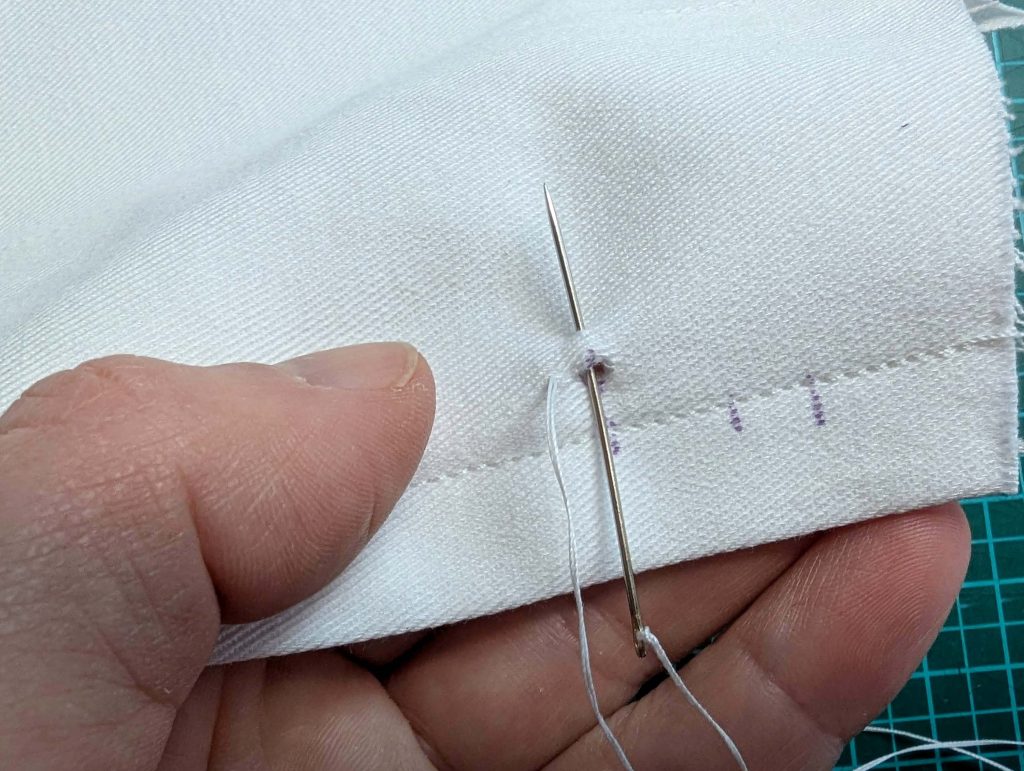
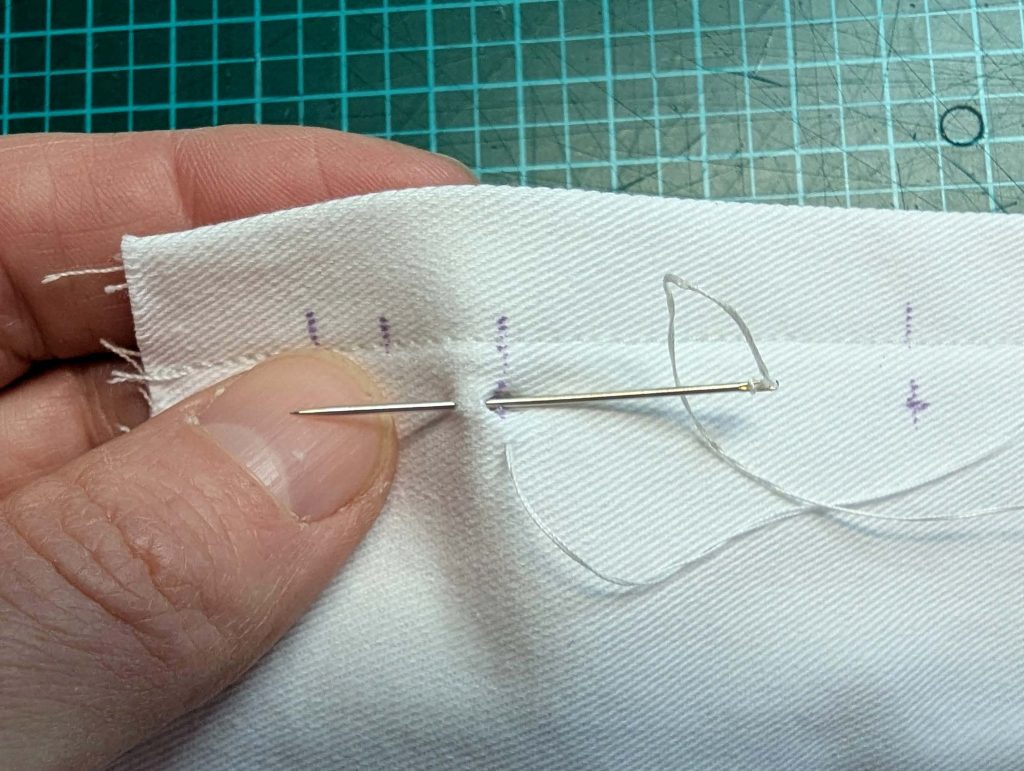
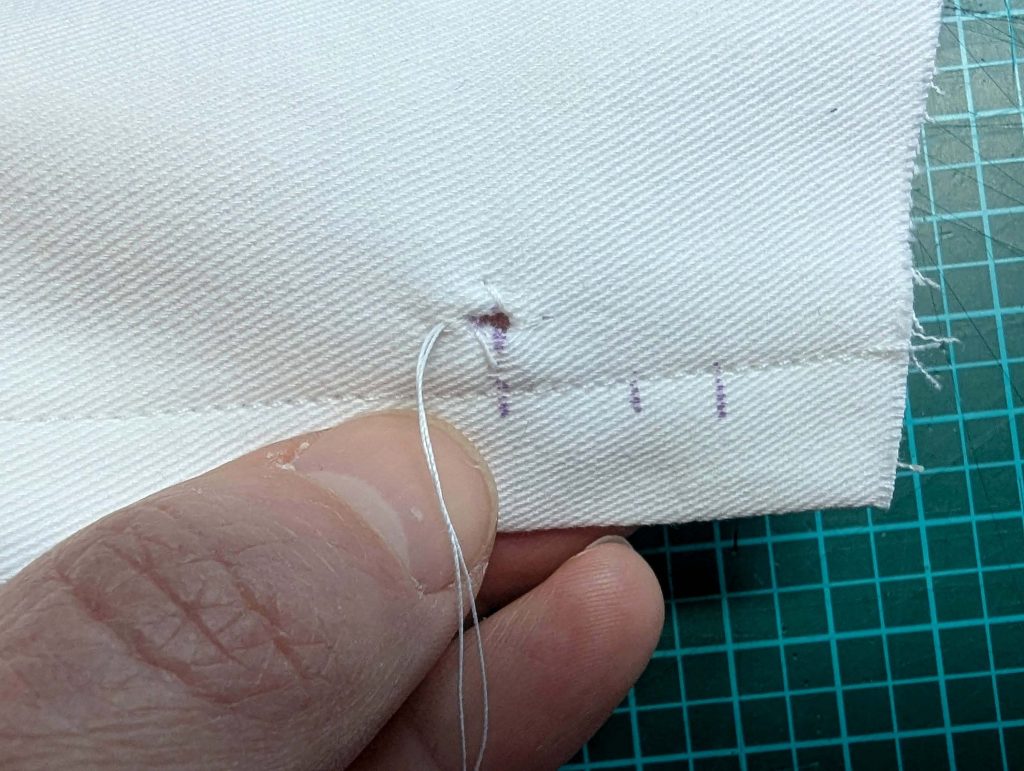
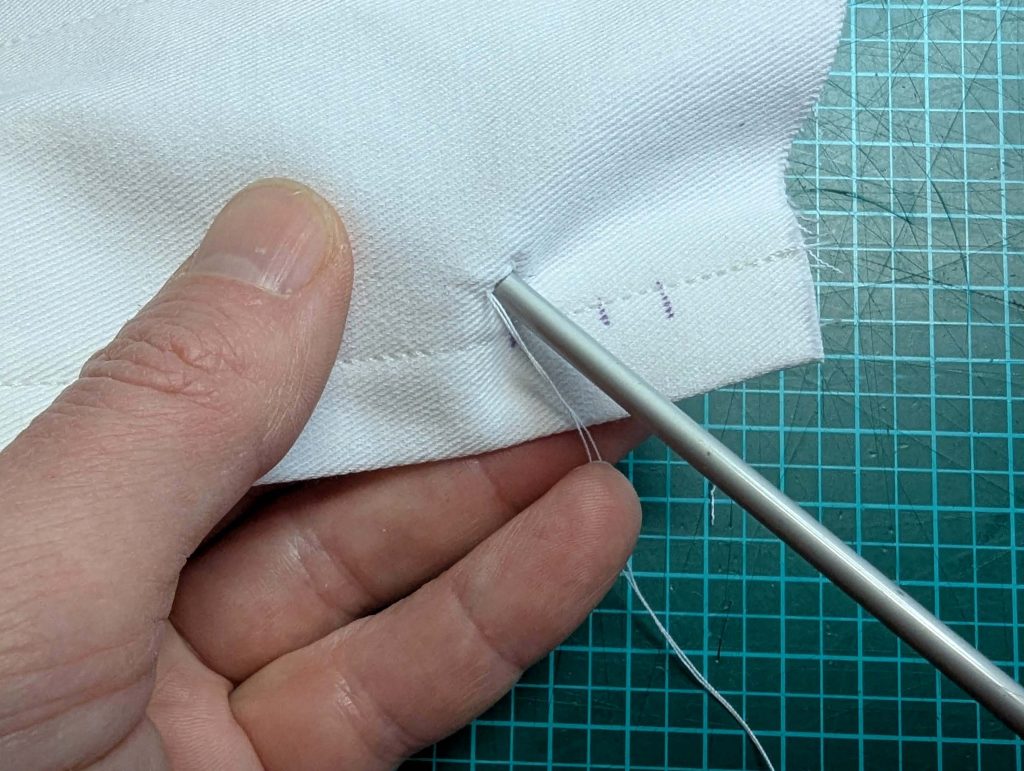
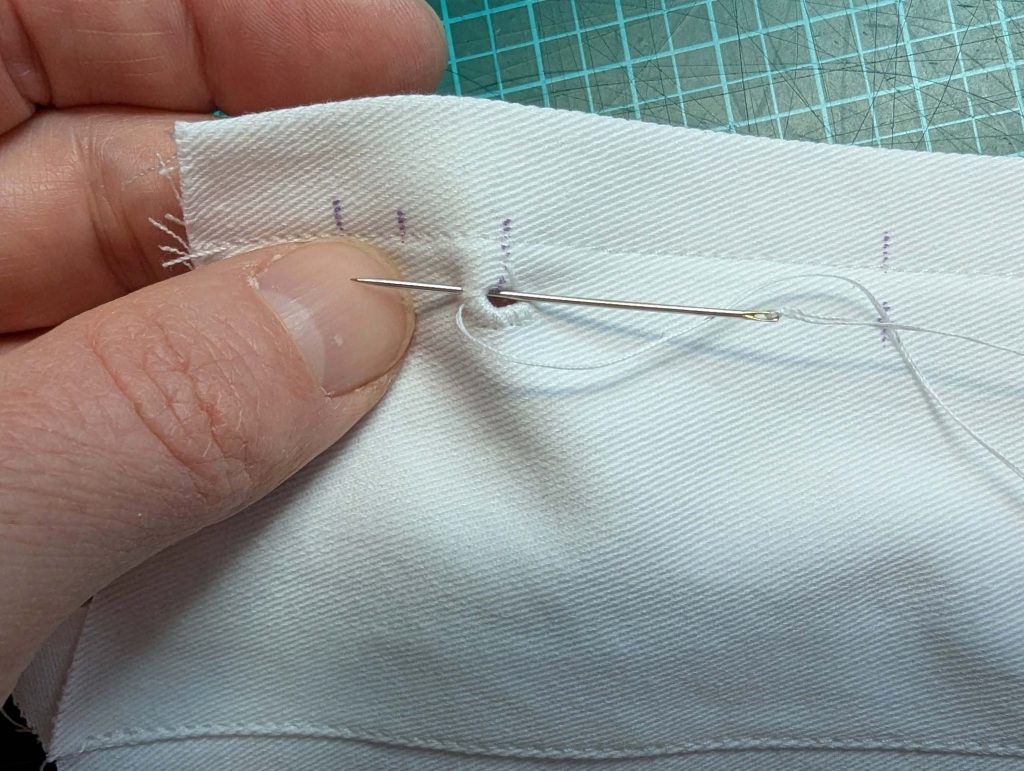
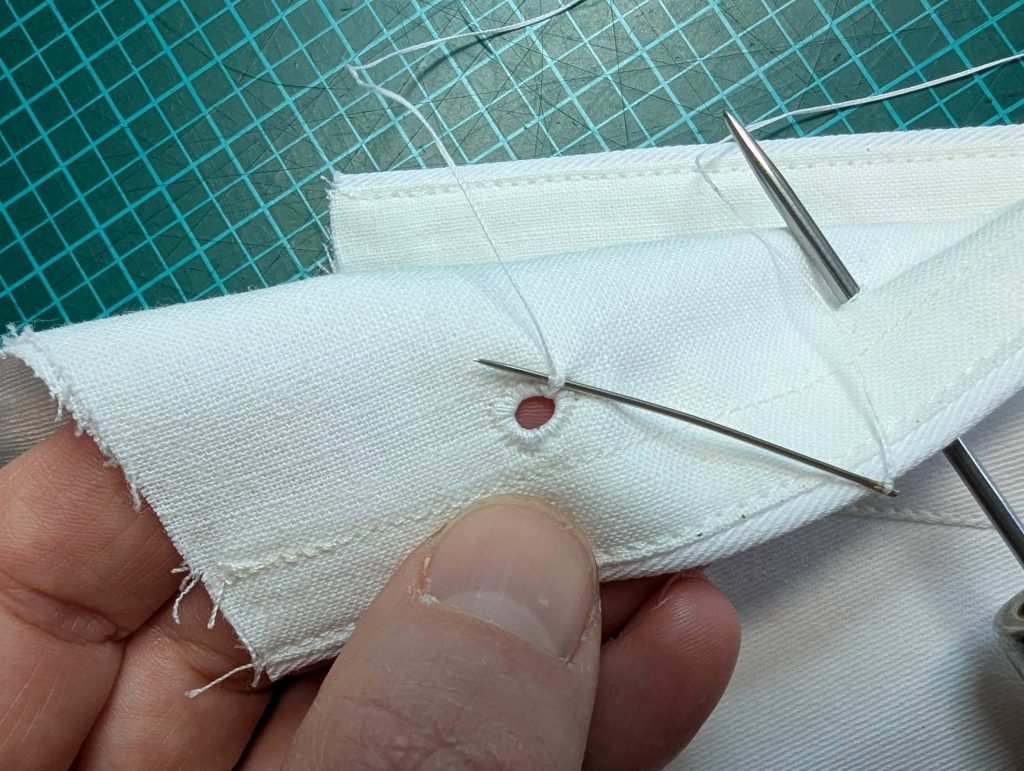
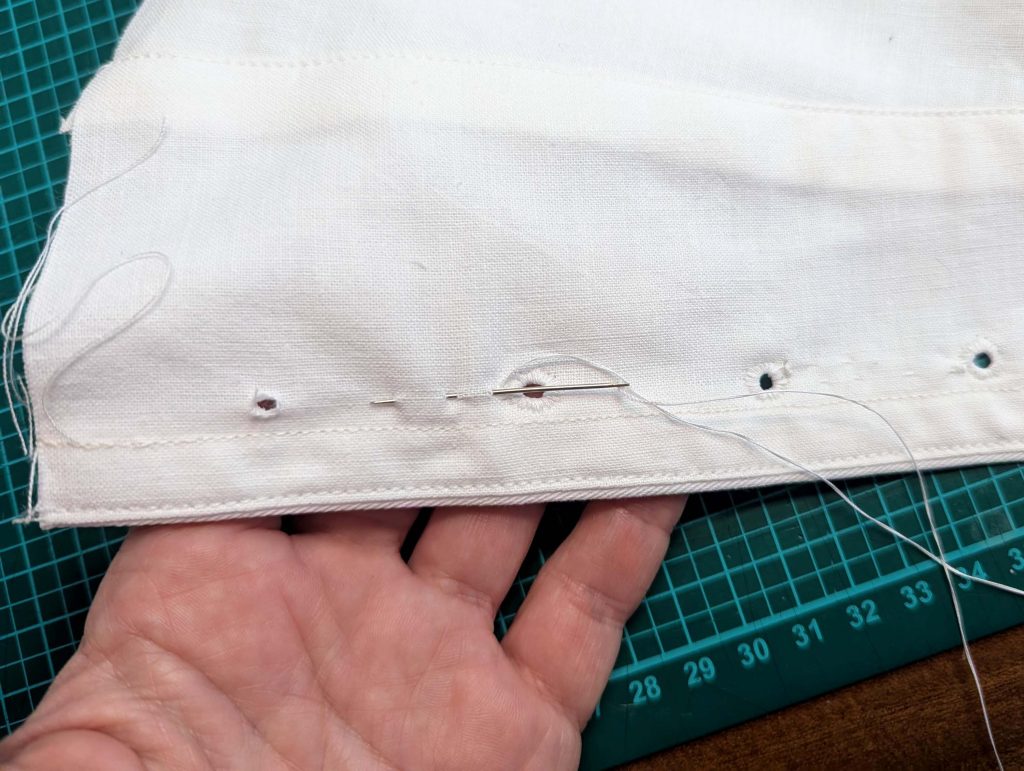
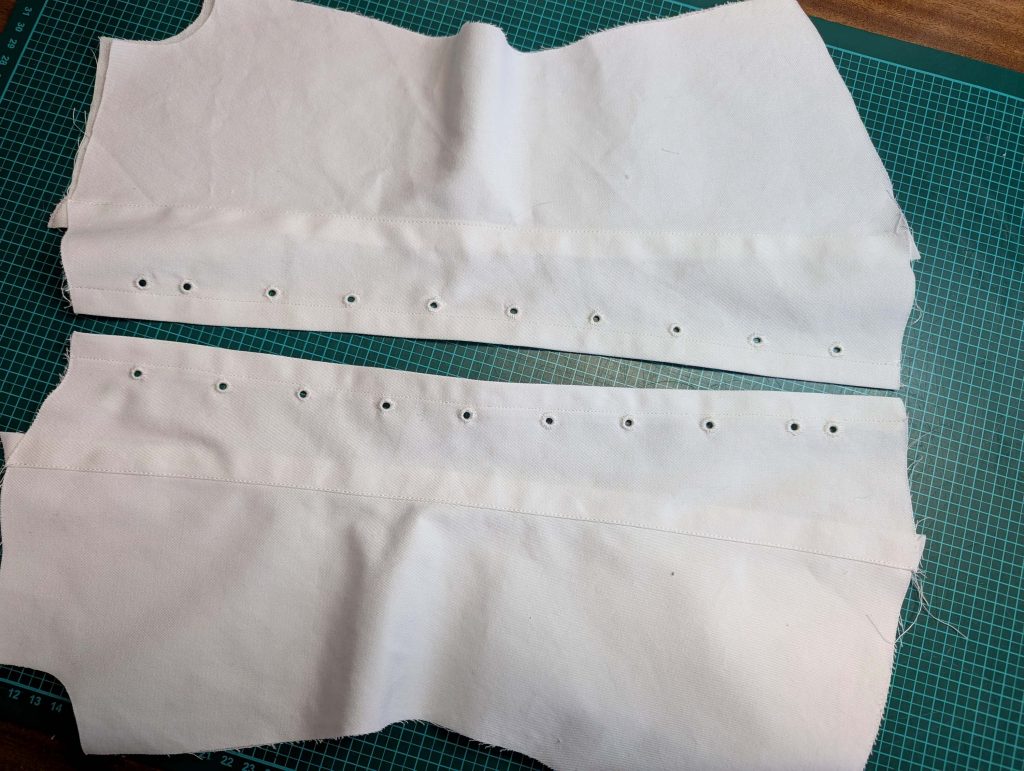
Optionally, sew tunnels for an additional light boning at the back, radiating regularly from the armhole, and ew the straps to the front, right sides together, trim back the seam allowance as described at the back, and topstitch.
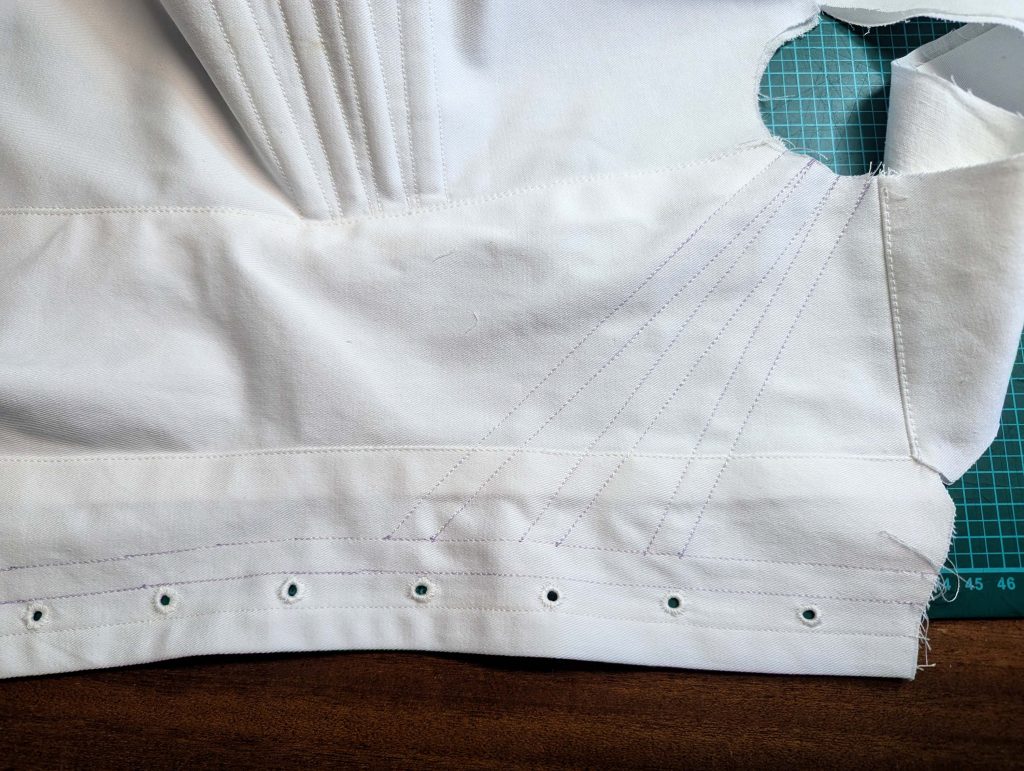
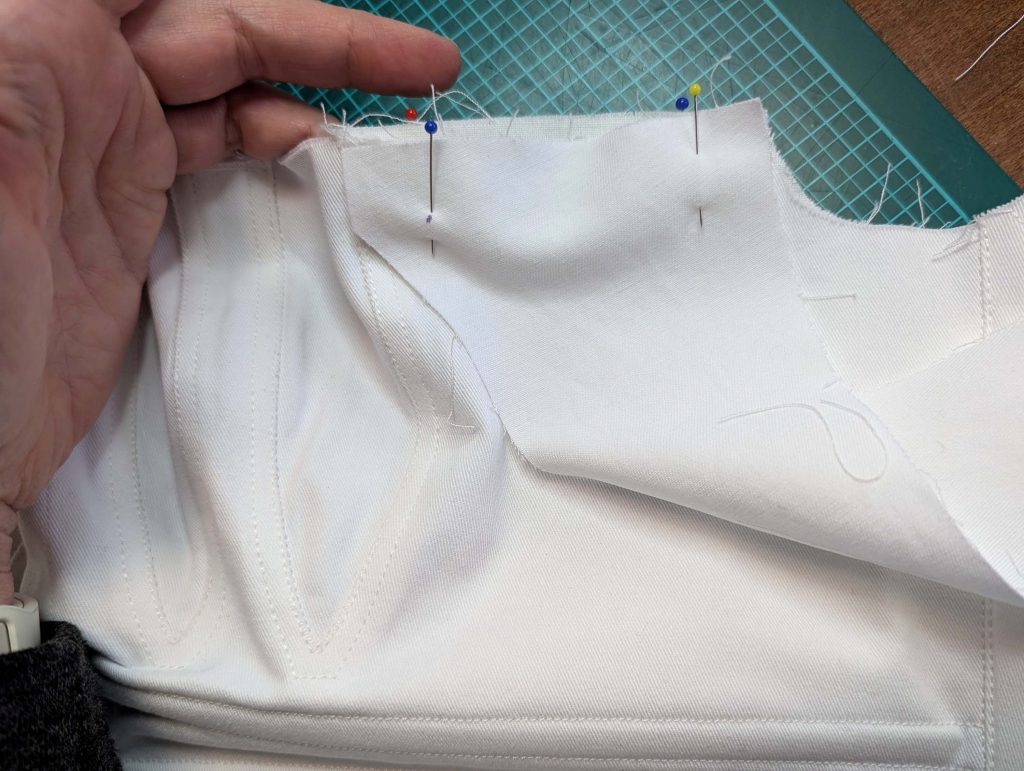
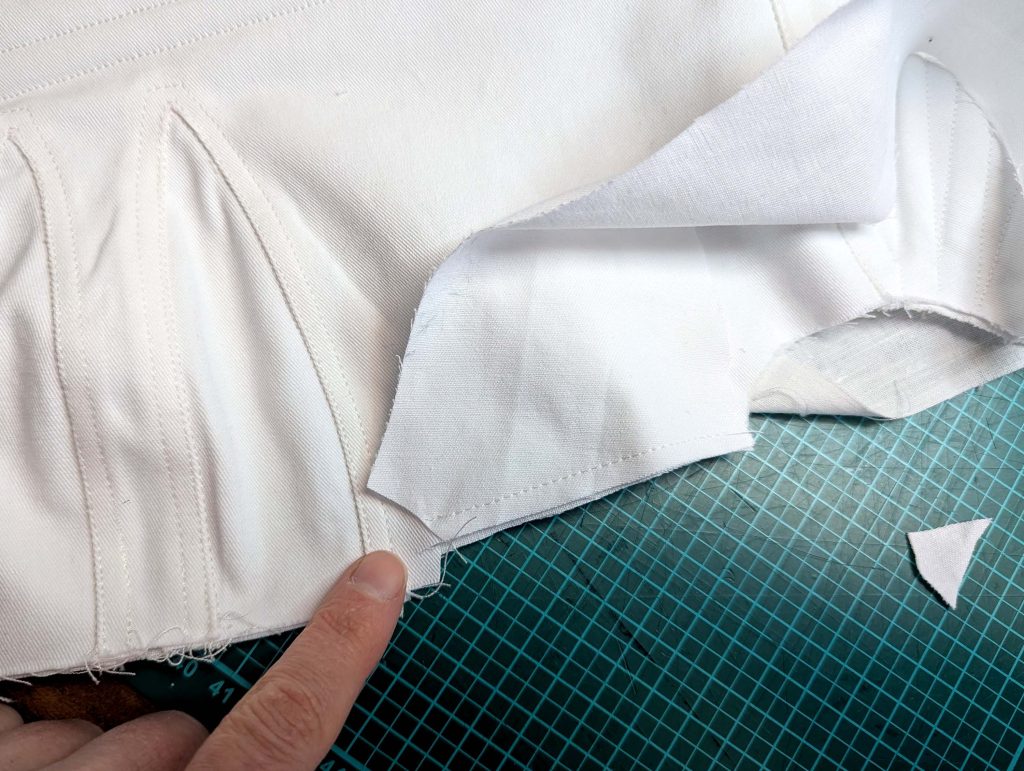
(6) Plan a fitting to adjust both straps and armholes. Check the neckline and length, and trim back when needed. For fuller figures, pay special attention to keeping the armholes narrow. Stitch along the neckline and armhole, about ¾” (2cm) parallel to the edge. Trim back the seam allowance of 5/8” (1,5cm). Take the twill tape (width 5/8“ (1,5cm) and fold it in half. Cover the raw edges of the neckline with that tape and baste in place through all layers, turning in a narrow seam allowance at the center back. I use a water-soluble glue stick to fix the ends before basting in place. Thread the tape with a drawstring, reaching from the center back to the center front on each side.
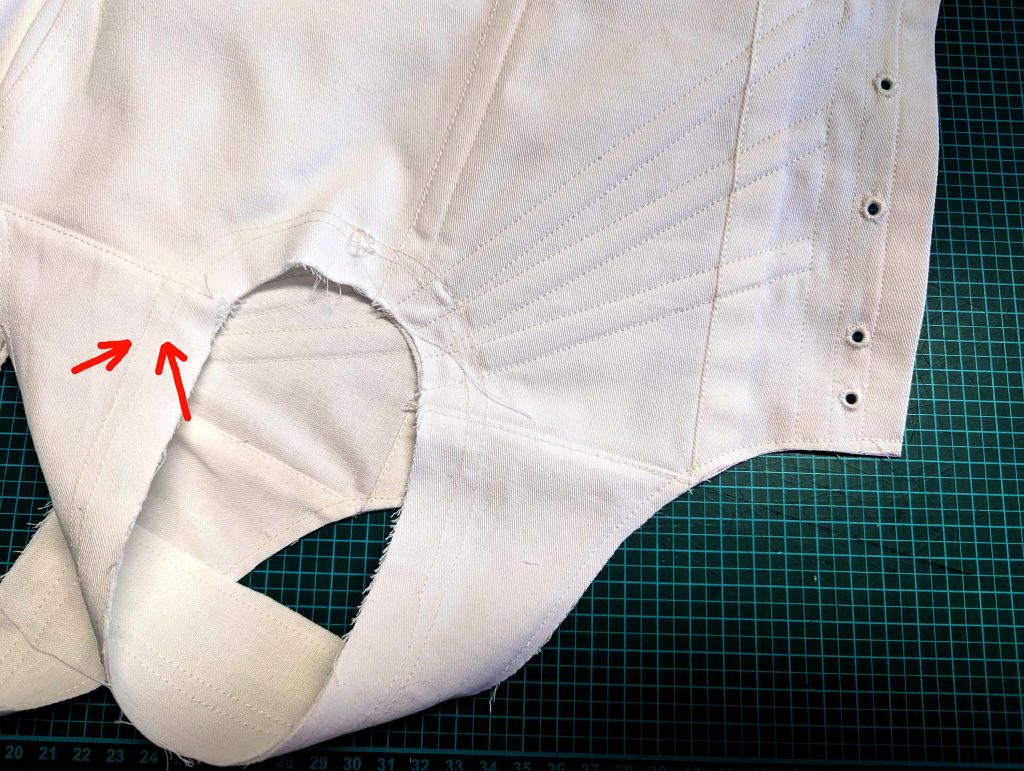
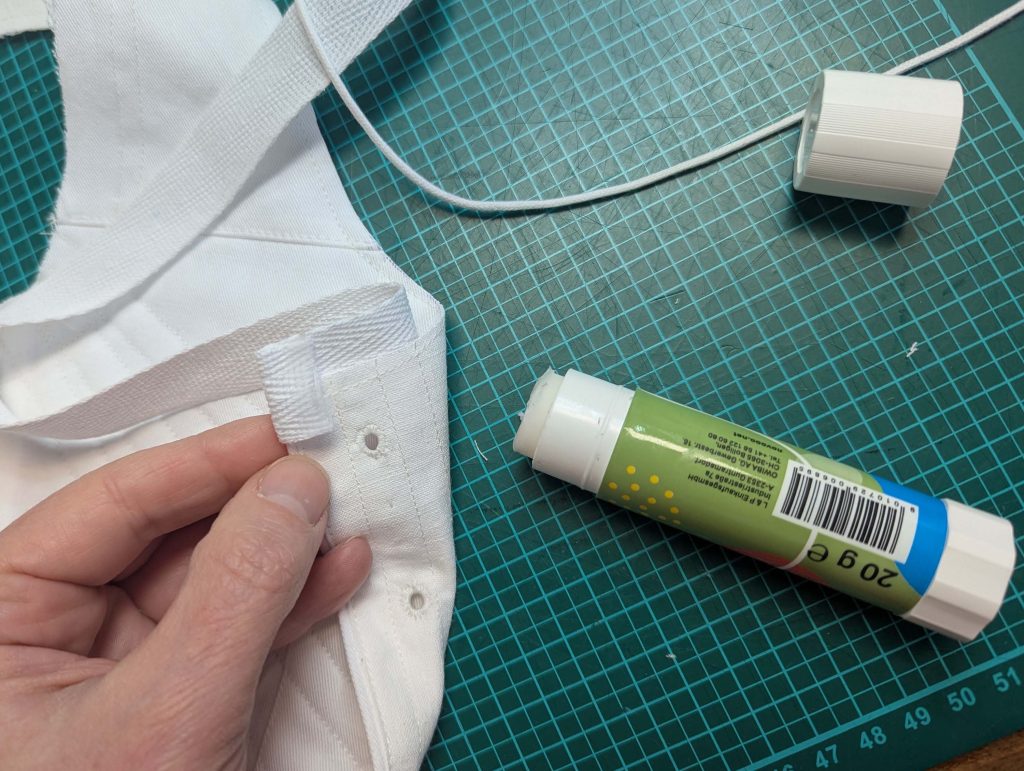
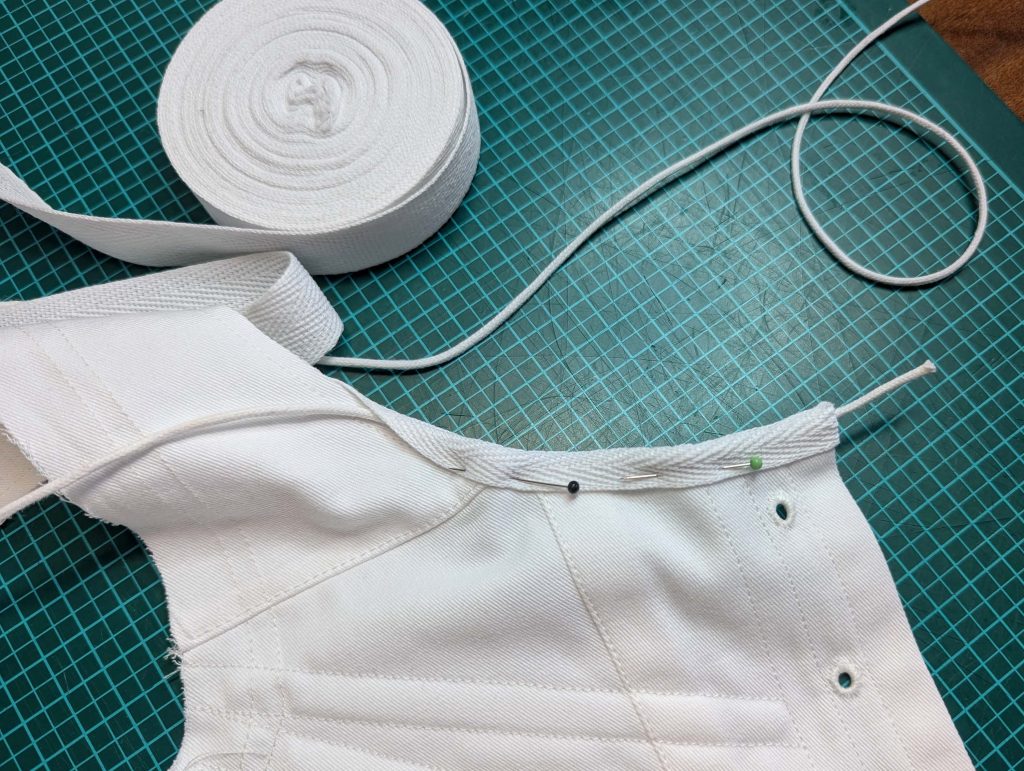
Sew eyelets to lead out the drawstring at the center front. At the center back, bar-tack the drawstring to the corset. Stitch the twill tape in place through all layers. Optionally, make a second row of stitching, creating piping when using a cord.

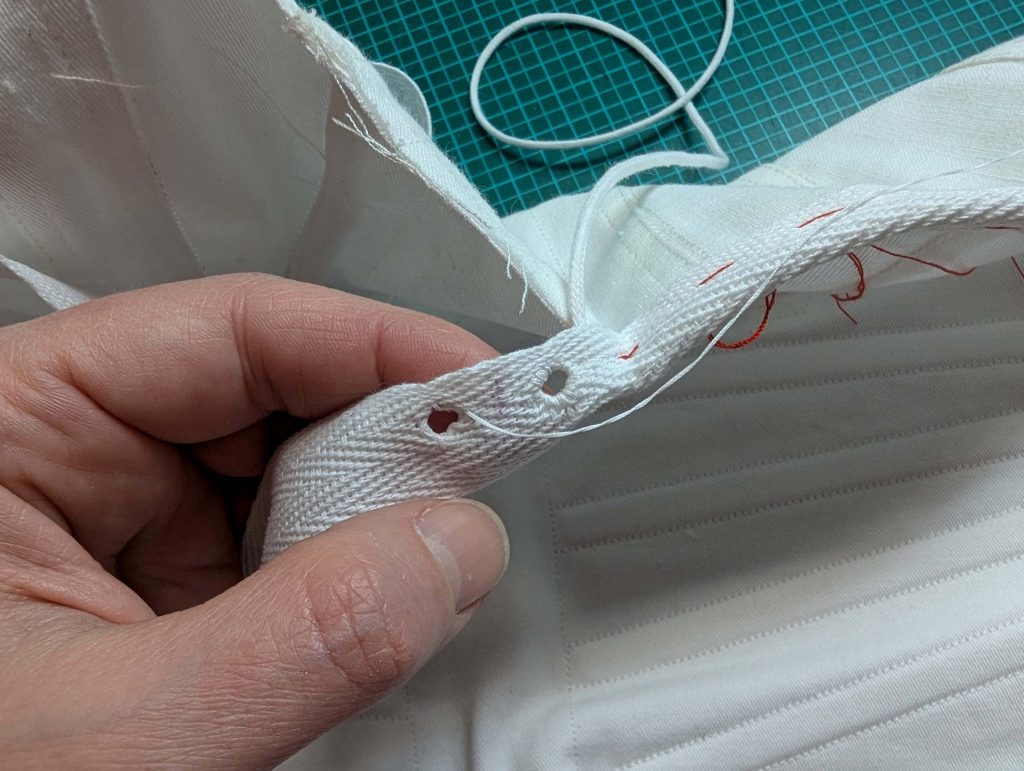
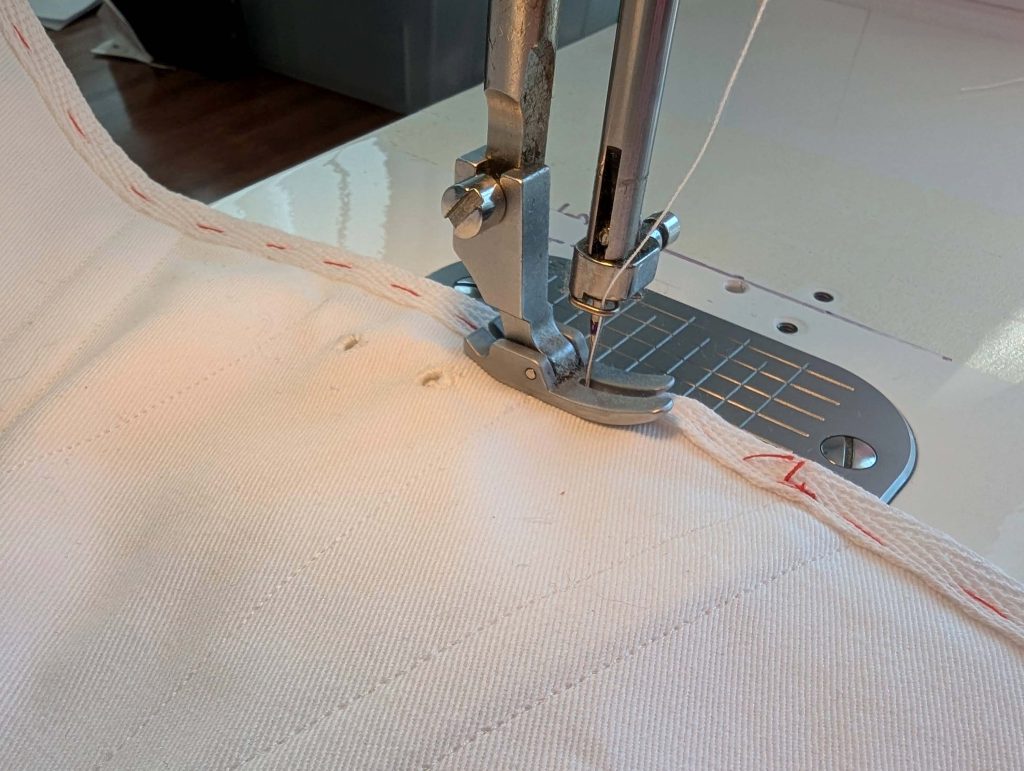
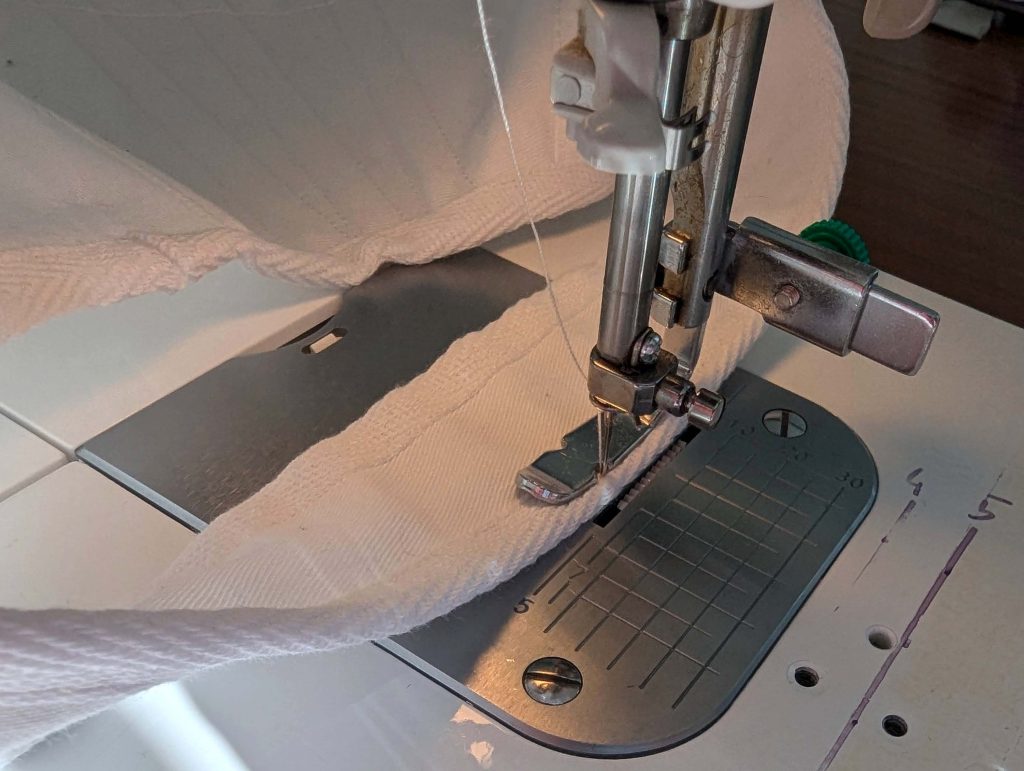
At the armhole, just finish the edges with twill or bias tape, without a drawstring. I made the ends edge to edge and not overlapping to avoid bulk.

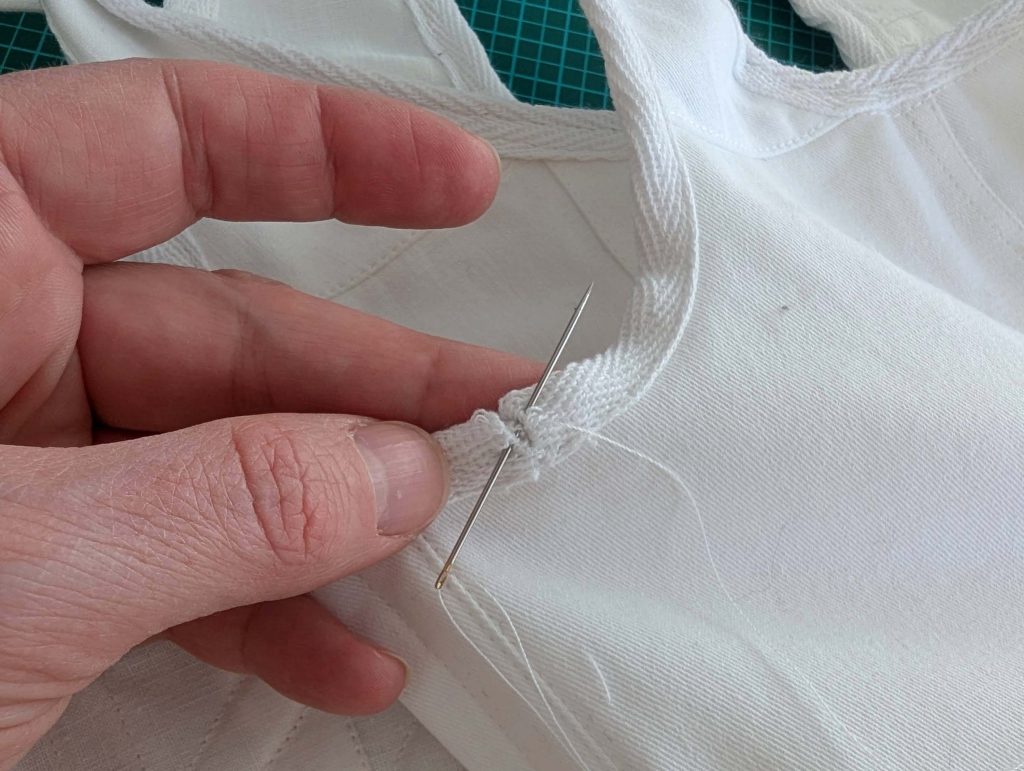
(7) To insert and remove the Knopfleiste entsteht. easily, clip the only lining towards mark (3), at the bottom. Trim back the seam allowance to about 3/8” (1cm) double turn in a narrow seam allowance and stitch in place. Trim back the remaining seam allowances along the bottom edge and finish with a twill or bias tape. Don´t forget to insert all boning first. Create four eyelets at the bottom edge of the busk pocket: two in the lining and two directly opposite in the fashion fabric. Thread a narrow ribbon through them and insert the busk. Secure the ribbon with a knot to prevent the busk from slipping out.
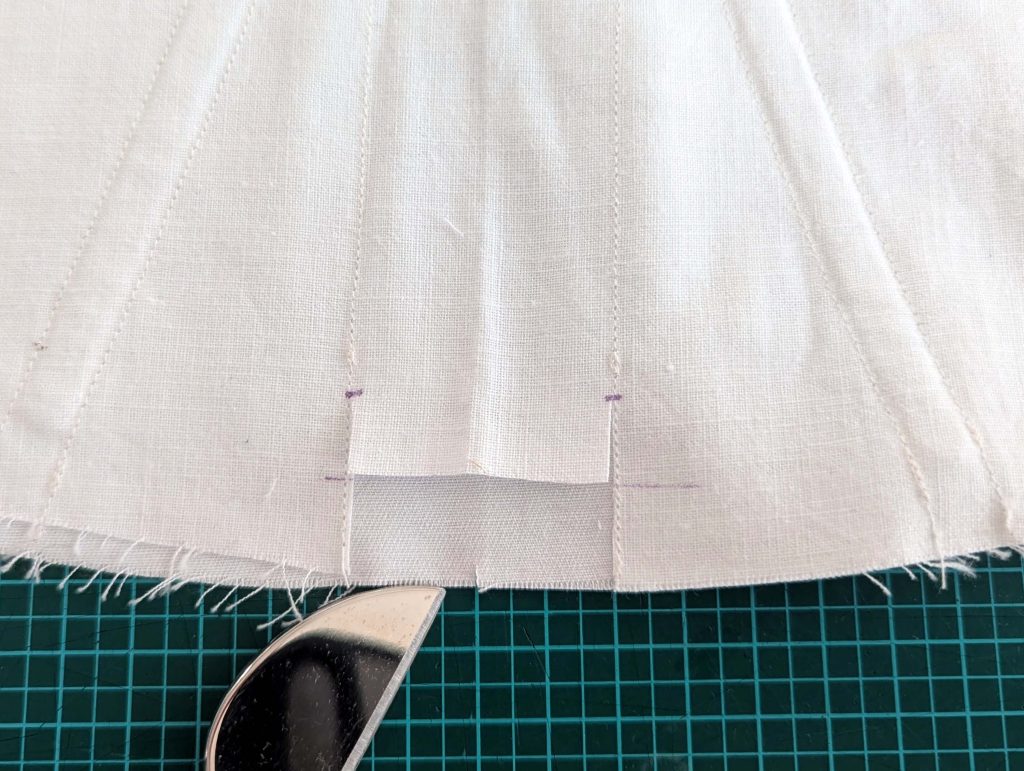
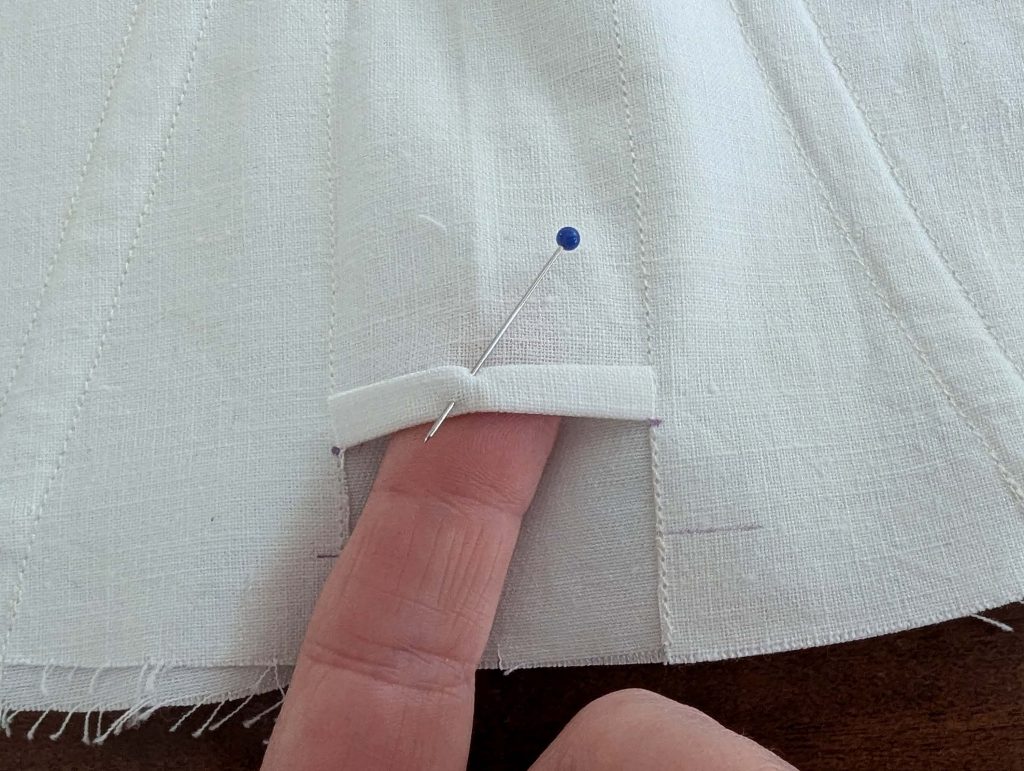
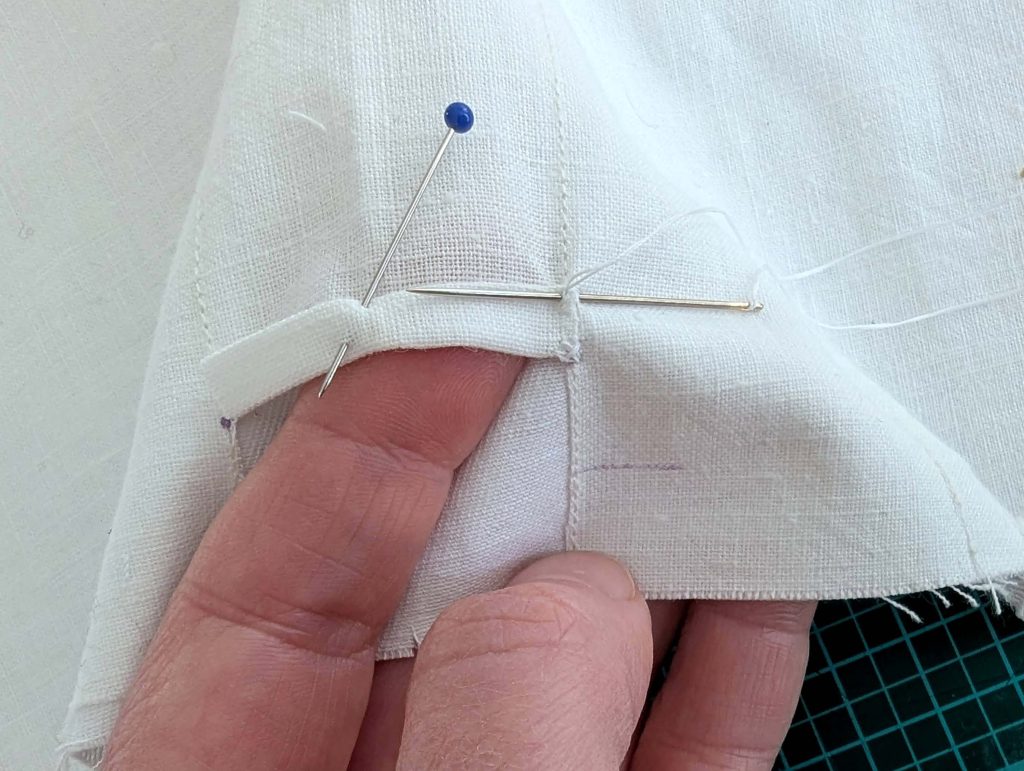
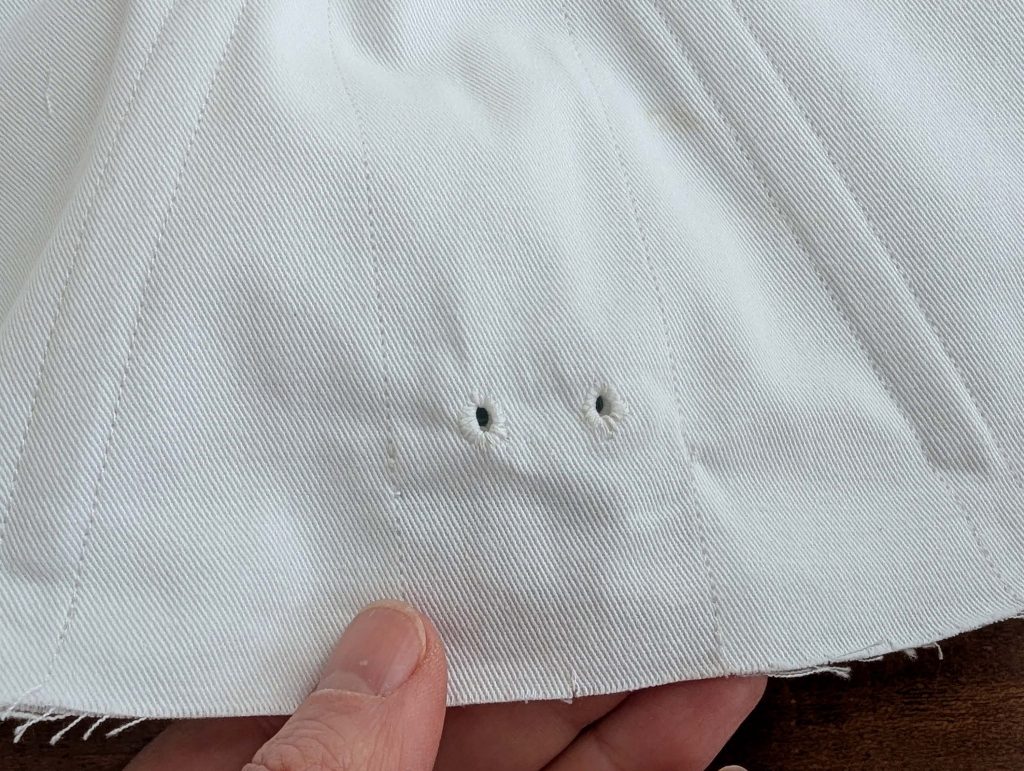


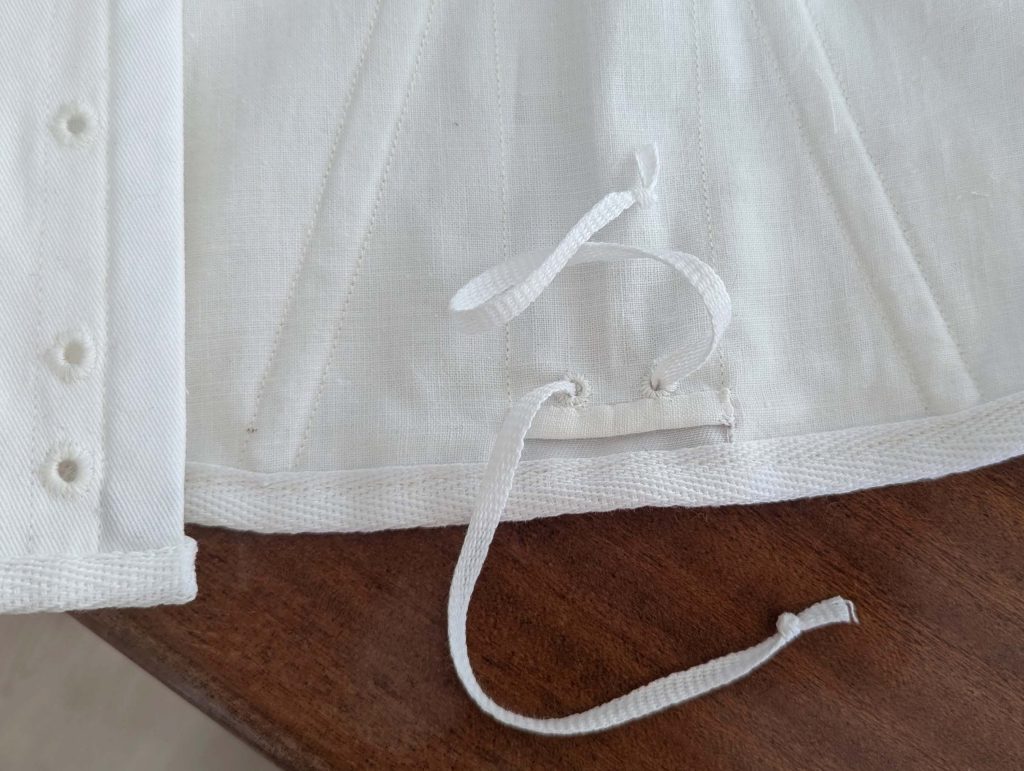
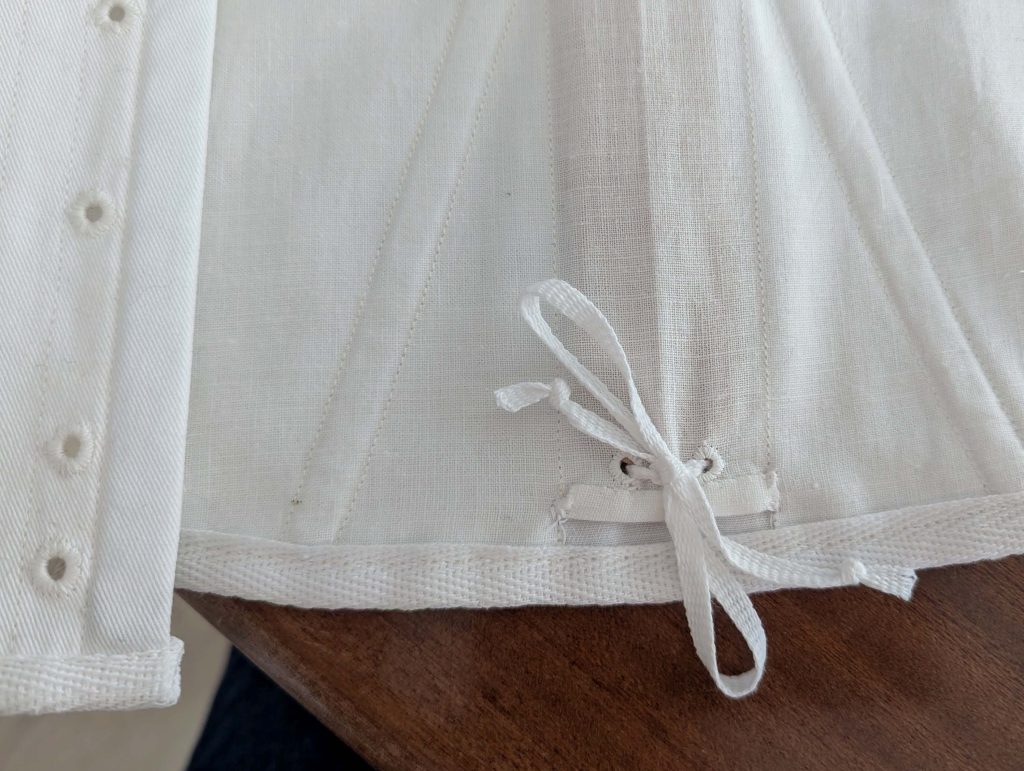
(8) Take the remaining piping cord and reinforce the ends with Fray-Check or heat shrink tubing, wax if wanted. Lace the corset, I prefer the method of putting on the corset with the back to the front and laced up with a shorter cord, then spinning around and tightening the lacing in the back, as shown in this video from Burnley and Trowbridge: https://www.youtube.com/watch?v=q8Isg0sBCpo
Got caught by the corset-making bug? Let’s try a dress to wear over your new creation!
